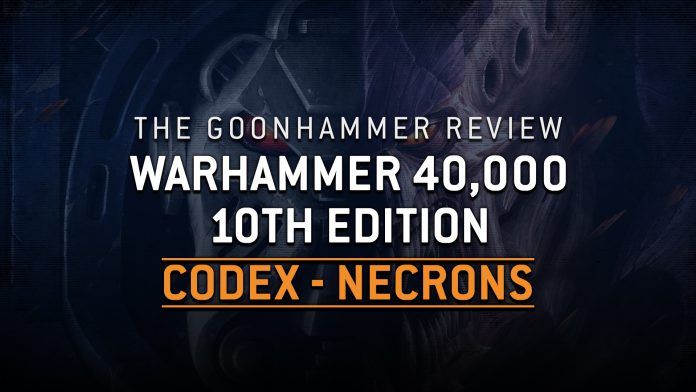Robots. Not in disguise. The Necrons have had a pretty good run of 10th Edition thus far, and now they’re rising from their tombs in full splendor, unleashing new detachments and updated rules to reclaim the galaxy from usurpers and old foes alike. Today, Wings and Gunum are looking at the new 10th Edition Codex for the Necrontyr, unpacking the selection of new toys that it hands to budding Phaerons. There’s lots to get excited about, so let’s dig right in!
We would like to thank Games Workshop for providing us with a review copy of the Codex.
Note: We do not yet know what the points for Necrons will look like when the book hits shelves. Given some of the rules changes in this book, we expect there will almost certainly be some changes, in similar fashion to Codex: Space Marines. We are broadly working off the current MFM points as a baseline, but expect some more takes from us when and if Games Workshop releases an update.
Army Overview
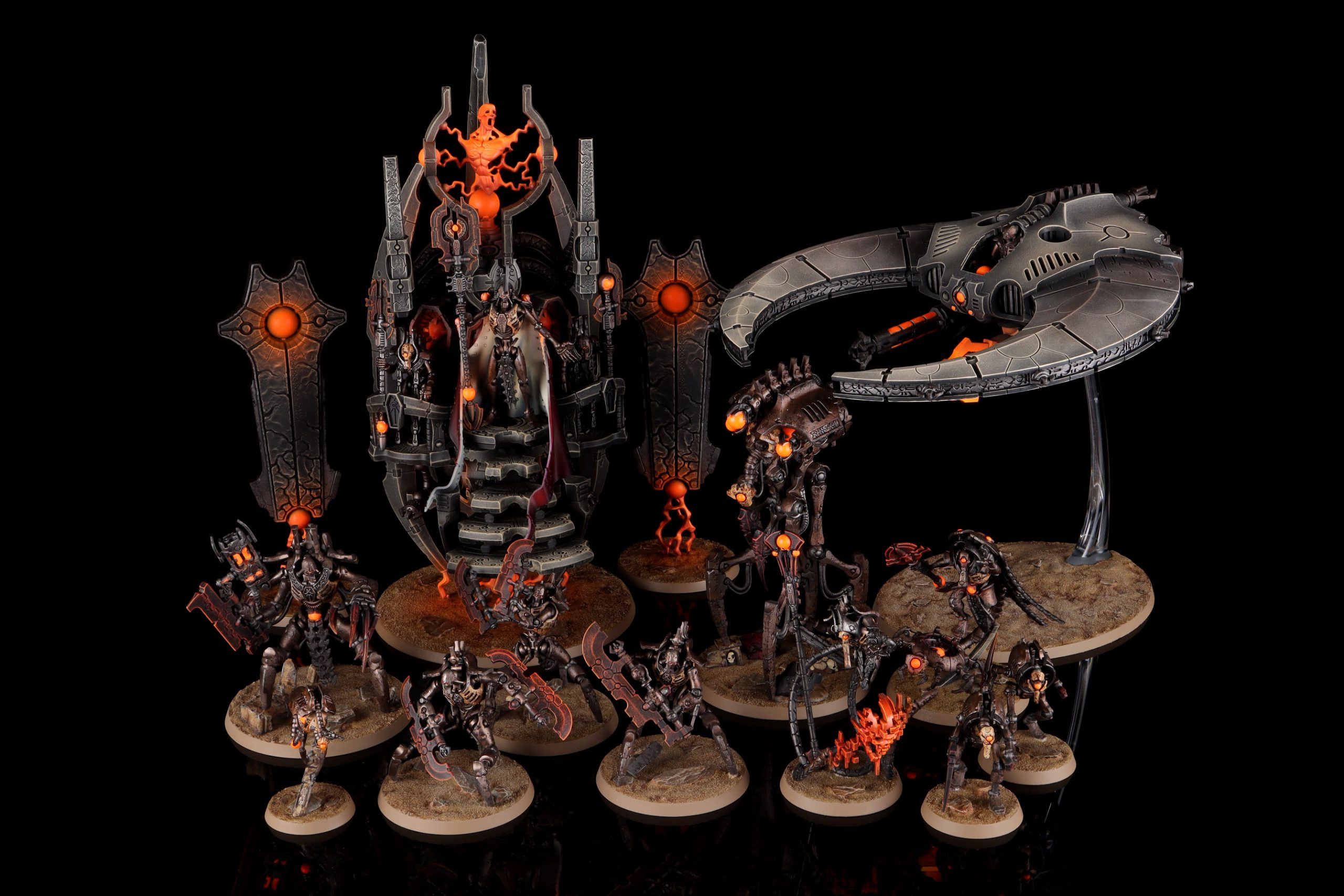
Holistically, both this and the Adeptus Mechanicus book have notably more changes from their Index versions than Marines or Tyranids did. Most of these changes pull things in a pretty healthy direction, which is encouraging as it hopefully means we’re not going to be cursed with some of the, shall we say, incautious choices in a few Indexes for the whole Edition.That’s right Aeldari players, we’re putting you on notice. Maybe.
We think the following are five standout positive features of this book:
- Diversity: This Codex does one of the best jobs we’ve seen so far of providing lots of different builds to try. One detachment does look notably stronger than the rest, but three more of them provide cool things to try, and some gentle tweaks to various datasheets from the Index help too. For this book, some nerfs to overtuned stuff from the Index (most notably some Reanimation bonuses and Lychguard deathbricks) also hit about right, which will help with encouraging people to try a wider range of options.
- The Canoptek Court: Speaking of a best detachment – the Canoptek Court looks very potent, and gives competitive players something to dive straight into.
- Synergy: One of the coolest things about the Necron Index was how much of a toolbox it was thanks to the focus on Leaders. Most of the other detachments retain some of that energy, but approach it from different angles.
- Wraiths: Friendship ended with LYCHGUARD, now CANOPTEK WRAITH is best friend.
- C’tan: The named C’tan get amped up even further, making them much more broadly compelling, and one of the detachments supports them particularly well.
There are also a couple of things we don’t like so much:
- The Destroyer Detachment: It tries, but it looks like Skorpekh are on the naughty list after 9th Edition.
- The Free Stratagem Dataslate Rule Clearly Needs a Change: The impact of the restriction of Free Stratagems to Battle Tactics is absurdly uneven in this book – some detachments have zero Battle Tactics, one has its best 2CP Stratagem as one. This impacts the AdMech book too, and GW needs to re-think this soon otherwise we’re going to have an edition-long division between later books that were written with it in mind and early ones that weren’t.
- Departed Friends: A lot of the resin Epic Heroes (Anrakyr, Obyron, Zandrekh, plus vanilla Lords) are gone, which is sort of understandable, but hits very strangely when they feature heavily in some of the narrative sections of the book. Hopefully they’ll get to join Imotekh and Orikan in getting en-biggened somewhere down the line.
Where’s Crusade?
You’ll find our review of the book’s Crusade rules this upcoming Tuesday.
Army Rules
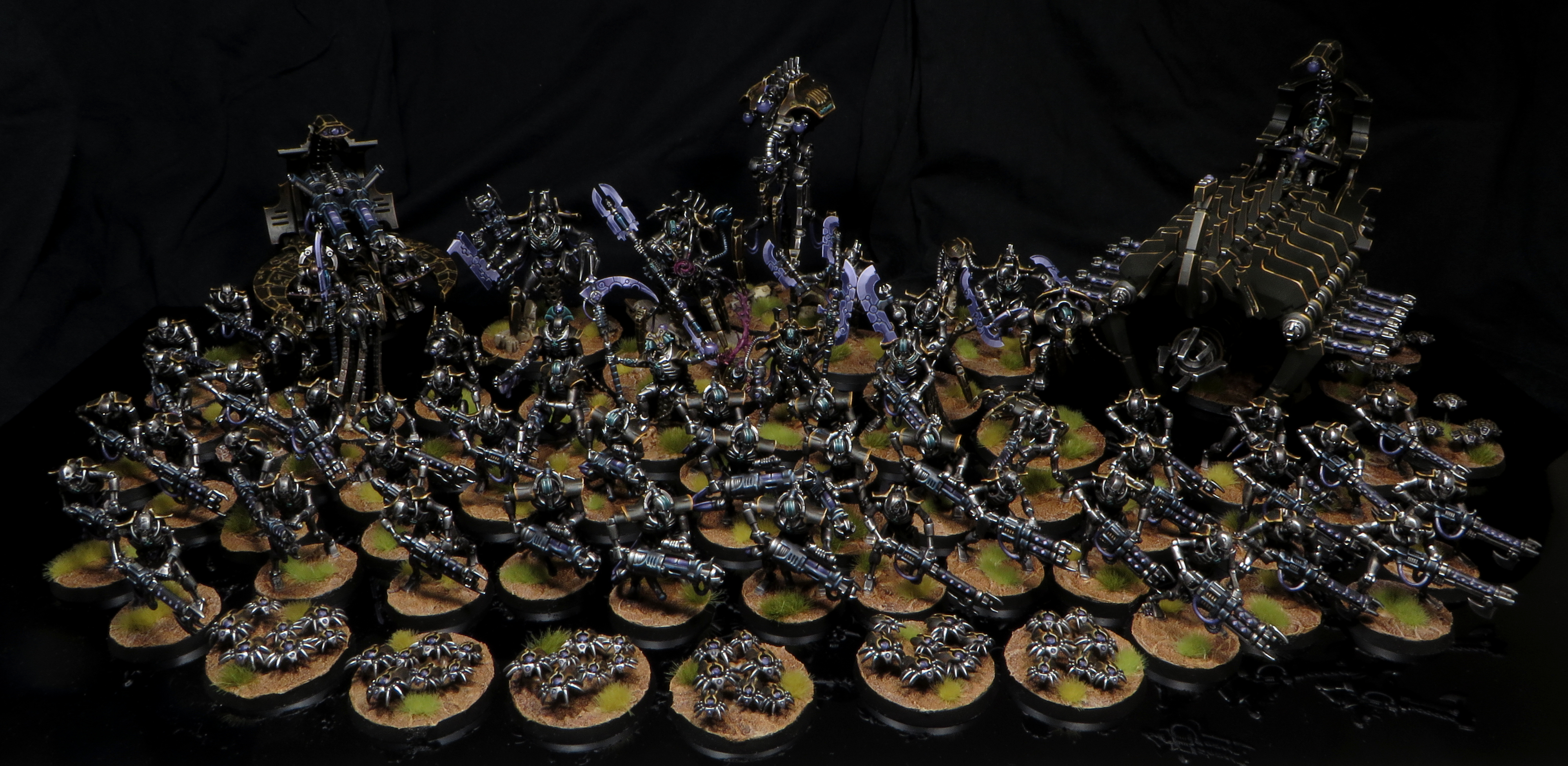
NECRON armies get access to the Reanimation Protocols army rule, representing their living metal bodies re-assembling themselves even after suffering catastrophic damage.
Reanimation Protocols
Every Necron unit has the Reanimation Protocols ability. As long as such a unit is on the Battlefield in your Command Phase, it regenerates d3 wounds. Each wound restored can either heal a damaged model or, if no model is damaged, return a dead model to the unit on one wound (then start healing it, or move on to the next dead model if it has 1W). This means that failing to fully destroy Necrons units can be disastrous for opponents, and can help you stay in the fight to the bitter end.
This rule is almost identical to how it appeared in the Index, with the only addition being the rider about being on the Battlefield (smartly heading off an obvious question about one of the detachments). What’s different in the Codex is that a lot of the tools that buff or interact with it have been toned down to a greater or lesser extent, which will make it feel a bit less insurmountable for some armies to deal with. Given the buffs and boosts elsewhere in the army, this should work out OK for the Necrons – the faction becomes more interactive, and less about presenting your opponent with bricks and hoping they can’t one-shot them.
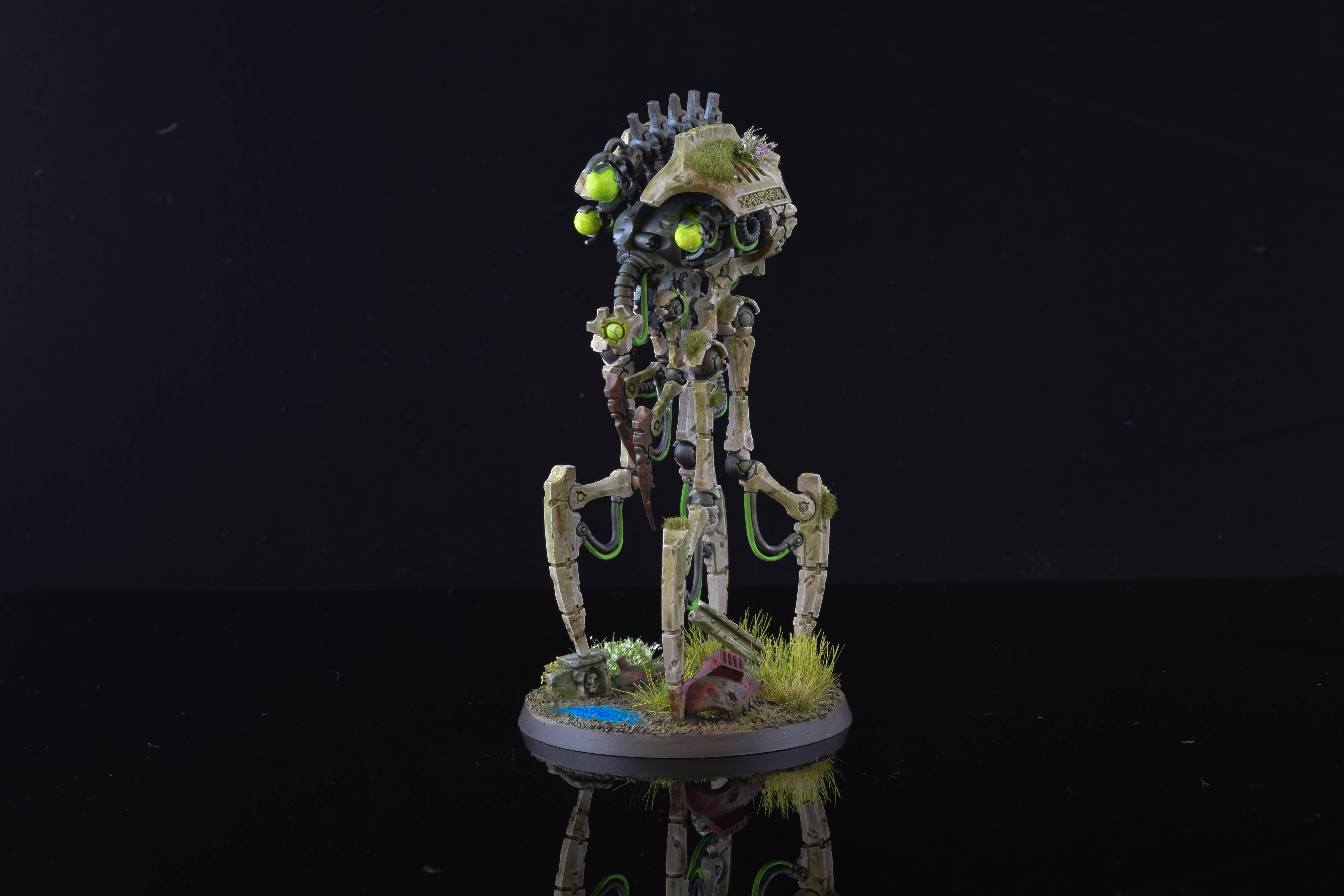
In terms of what support is out there, the big ones are the Canoptek Reanimator and Resurrection Orbs, plus various Stratagems that can trigger Reanimation at unusual times (e.g. after losing a model to an attack or after an opponent declares a Charge against a unit).
The Canoptek Reanimator still provides a powerful +d3 additional wounds to a unit each time it Reanimates, but now does so at only 3” rather than the rather silly 12” aura it had before. It retains a strong defensive profile, but you can’t now leave it sitting on a home objective and still have the aura reach your whole army.
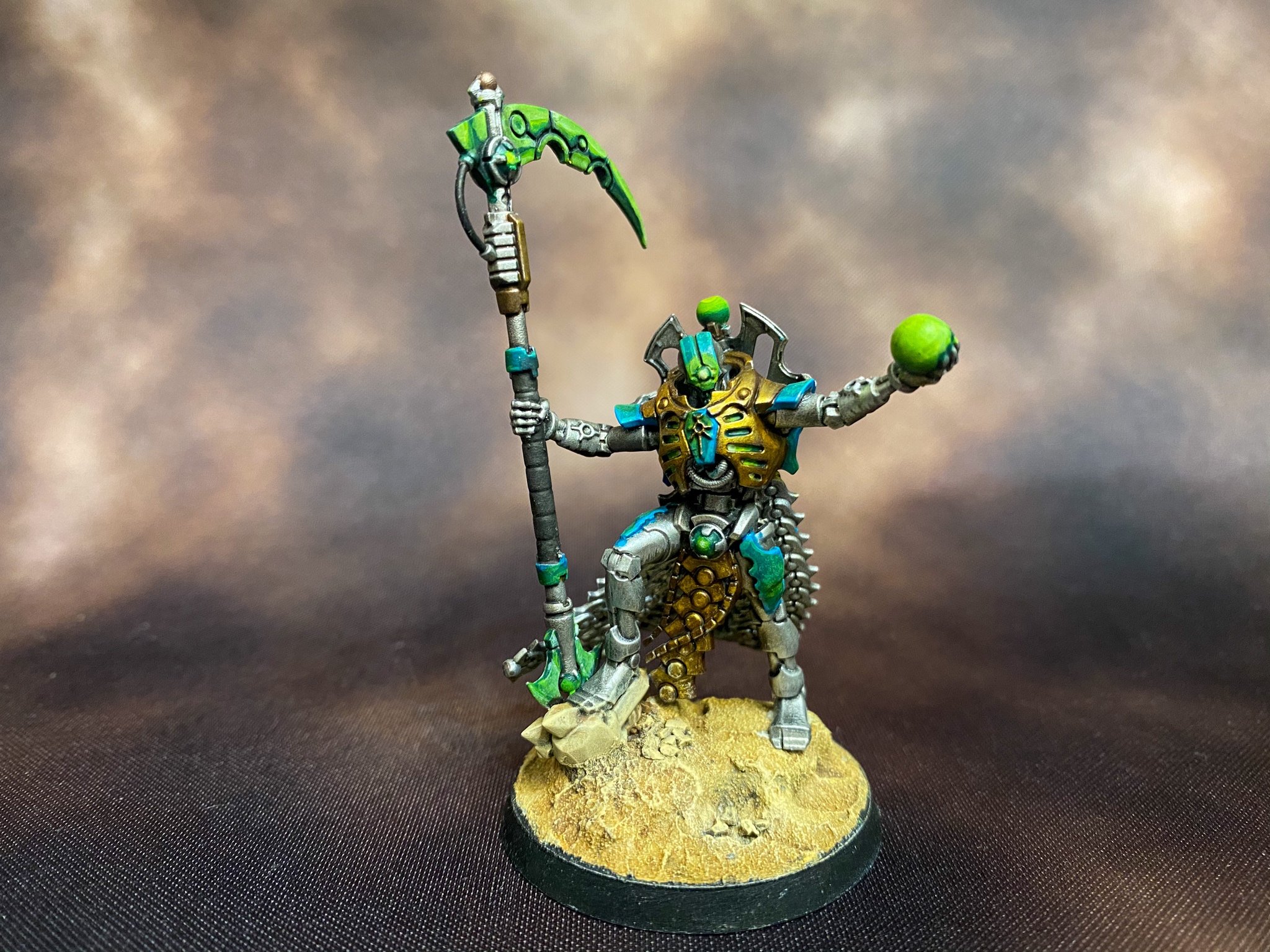
Resurrection Orbs get more of a sidegrade, and are pretty cool. Rather than reanimating in your opponent’s Command Phase as well as your own, these now provide a once-per-game shot in the arm (which you can use a maximum of one of per turn), letting you reanimate at the end of any phase in either player’s turn, and getting d6 Wounds back rather than d3. This is a genuinely interesting revamp that probably ends up better than the old version taken in combination with other stuff in this book. The indestructible Lychguard deathbrick has been given a stern talking to, and Warriors no longer get additional wounds reanimated at baseline (they re-roll dice instead), so there’s a solid chance you get more value out of a one-time spike than a steady clip. It also makes the Orb on the Catacomb Command Barge extra useful, as it gives you lots of flexibility to protect surrounding units.
One final point worth raising – reanimating Cryptothralls is no longer as dumb as it was before. Yeah, yeah, laugh it up players-of-every-other-faction. They no longer have their Feel No Pain, and while they get an extra wound in partial compensation, that’s obviously less good as synergy with Reanimating.
Gunum note: This is also a slight nerf, as they now eat up three of your reanimation wounds. You’ll have to decide if you need some more guns or a 3+ armor save when it comes to your warriors.
Detachments
Necrons now get five different detachments to select from. Index superstar the Awakened Dynasty returns with a few tweaks, and the Codex adds the destructive Destroyer Cult, cunning Canoptek Court, elite Obeisance Phalanx and mobile Hypercrypt Legion.
Our current hot take is that the Canoptek Court is extremely strong, the Arisen Dynasty, Obeisance Phalanx and Hypercrypt Legion are cool and can be put to work, and the Destroyer Cult is pretty terrible. Sorry Skorpekh fans. Let’s take a look at what each offers.
Awakened Dynasty
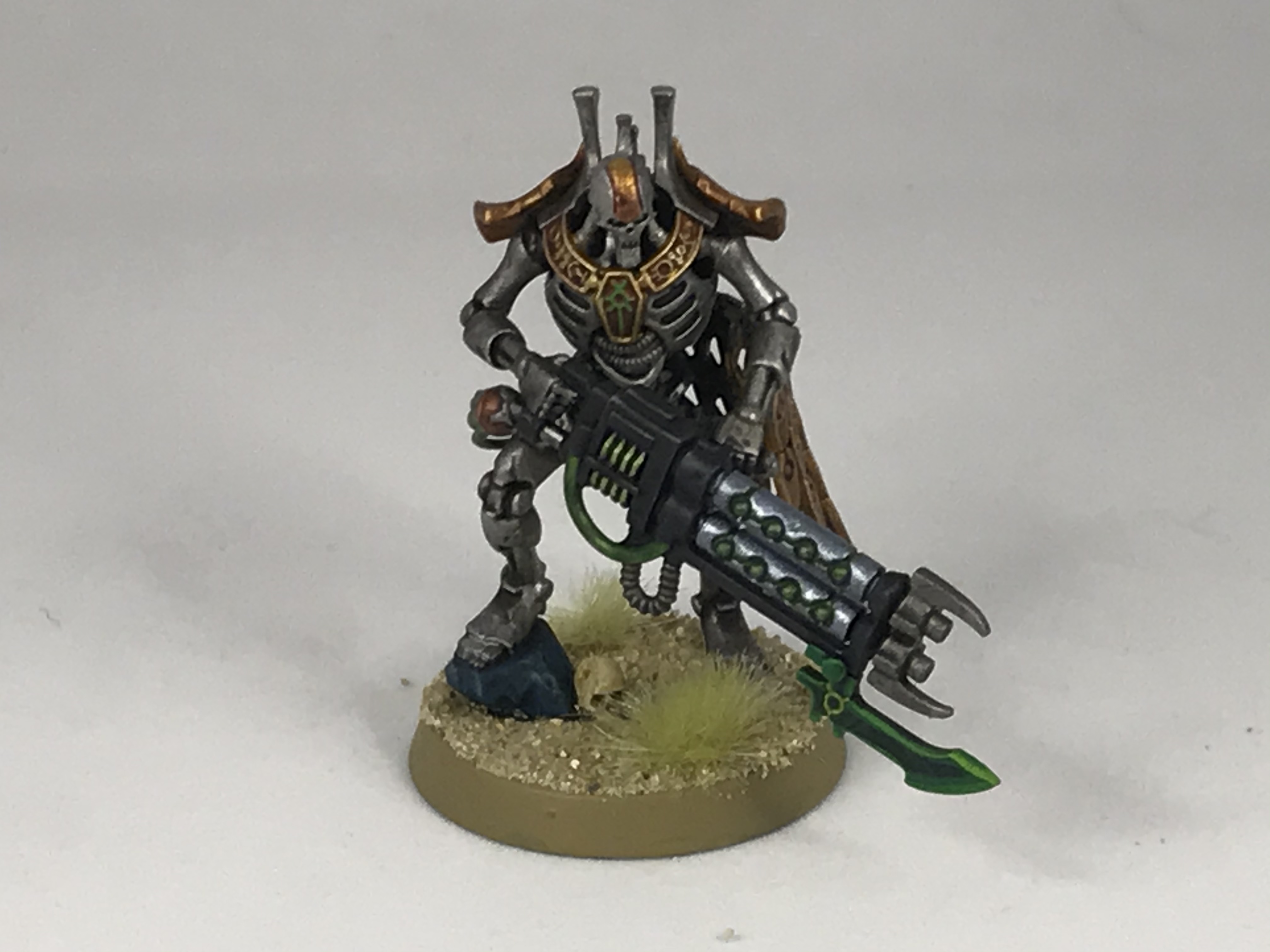
The Awakened Dynasty, centered around Leaders, arises once more, mostly familiar but with notably more changes to it than we saw in the Tyranid or Marine books. These probably end up tweaking the detachment’s power level down slightly, but some are sidegrades rather than strict nerfs, and some of the improvements to units in this book (particularly how well Wraiths now work in it) should ensure it’s still a very viable choice.
Detachment Rule – Command Protocols
The Awakened Dynasty’s detachment rule is unchanged – while a Necron Character model is leading a unit, it gets +1 to hit. Simple, clean, very effective and now exceptionally good with Canoptek Wraiths, because Technomancers are now eligible to lead them.
While the rule itself doesn’t change, there is one thing to note here – the Sovereign Coronal has gone, replaced by the Phasal Subjugator, which just adds +1 to hit rolls instead of making a unit count as being lead. This is still good, but it means that if you want to enjoy the other benefits of being lead in this detachment, you need an actual leader.
Enhancements
As an Index detachment, the suite of Enhancements here is very much an all-rounder mix. First up, as above, the Phasal Subjugator provides an Aura of +1 to hit for non-Character units, obviously great if you’re planning to bring a gunline of tanks alongside your Infantry blocks.
For those Infantry blocks, you’ve got two upgrades – the classic Veil of Darkness, providing a once-per-game teleport for the unit, and the Nether-Realm Casket, which gives a unit Stealth. The latter is a bit of a downgrade from its old form as the Hypermaterial Ablator (no longer providing Cover outside 12”), but still potentially valuable, and pretty good for taking a Wraith unit from very tough to extremely tough.
Finally, for herohammer purposes you have the Enaegic Dermal Bond, providing a 4+ Feel No Pain to the bearer. Transcendent C’tan can no longer take Enhancements, but this is still very strong on a Catacomb Command Barge, creating a hefty brawler. Expect to see all four of these used.
Stratagems
Necrons Stratagems were some of the best in the Indexes, and though there are some tweaks here the suite remains extremely strong.
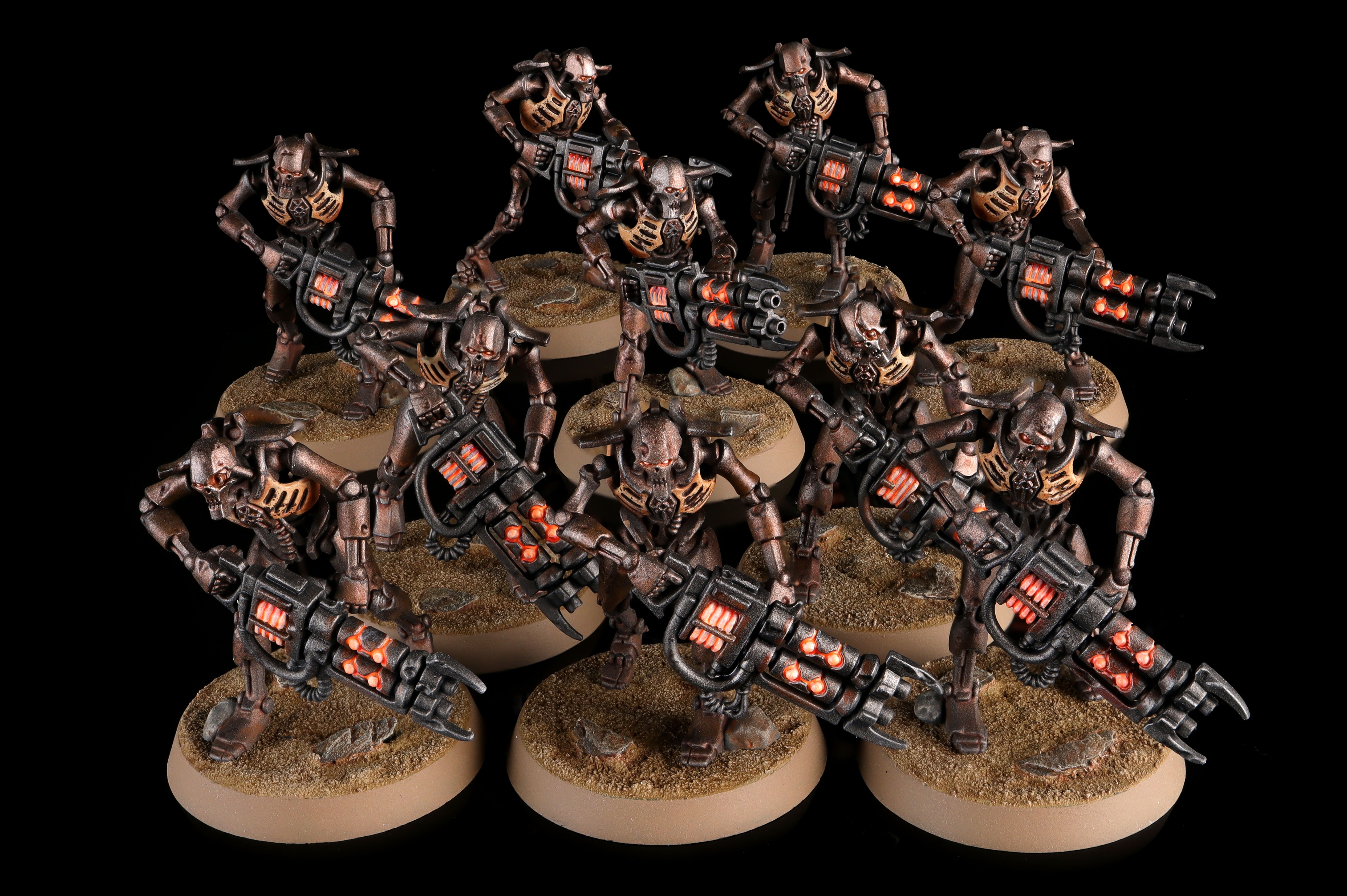
Three unchanged ones first. Every Necron player’s favourite Stratagem, Protocol of the Undying Legions, which allows reanimation immediately after being shot and losing a model, is back. It’s worth bearing in mind that it doesn’t have quite as much synergy support as before (between changes to Warriors, Cryptothralls and Reanimators), but it’s still very potent, and ideal for messing up the opponent’s murder maths. For getting your toys around the table, Protocol of the Sudden Storm also comes back, turning your weapons Assault, and providing re-rolls on an Advance if your unit is being lead. Don’t forget that as well as getting Warriors in position to kill stuff, you can also use this for some extra reach before doing an Action-style objective. Finally, Protocol of the Hungry Void still provides +1S in melee and +1AP if being lead, but this notably benefits from having a smash hit new target in Wraiths. Going from S6 AP-1 to S7 AP-2 is utterly game-changing, and I expect to smash this button a lot more with the new book.
Next up, the minor tweak. Protocol of the Eternal Revenant, which lets a dead Character stand back up, now works like every other version of this effect and triggers at the end of the phase (though there’s still no 2+ roll, which rules). This mostly nets out as a significant improvement, outside of edge cases of someone sniping out a Technomancer with a Vindicare or whatever. The old version was fine, but if your opponent had lots of attacks or Mortal Wounds “stacked” then you could just immediately die again. Now you’re guaranteed to make it to the next phase, which is especially strong with Imotekh and Szeras, the former because if they charge and kill you then you can get back up and Call the Storm in the middle of their army, the latter because he’s a complete bastard to kill, and now if they do it in the fight phase they get the “fun” of starting again from 5+d3W after he pops up and Reanimates. This is a very good change for the detachment, and is a real draw.
The last two get substantially bigger changes. First is Protocol of the Conquering Tyrant, which is significantly weaker. Instead of providing full wound re-rolls as before, this now provides hit re-rolls of 1 within Half Range, or full hit re-rolls in Half Range if a Character is leading the unit. This does work well with all the Critical Hit tricks that Necrons have, and the army was a bit short of hit Re-Rolls before, but the punch-up capability of Wound Re-rolls was extremely good. Where you might consider this is on Enmitic Lokhust Heavies, as with a Lord it lets them rack up absurd numbers of hits, but even there losing the ability to try and chip vehicles hurts. Still not a bad Stratagem, but a definite loss in power.
Gunum note: I am on the other side of this, as I think this is a huge upgrade for any units that use Gauss or Tesla. Immortals of all varieties and Warrior bricks are now going to be able to dig hard for their juicy Sustained Hit 2’s and Lethal Hits. Necrons seem to have the most weapons with Critical Hit modifiers, so seeing this change is a huge win. Don’t forget about those Plasmancers making those crits on 5’s! A strong, positive change in my opinion.
Finally, Protocol of the Vengeful Stars gets a complete re-work, and I honestly had to read this a few times to fully wrap my head around it. This now runs you 2CP (all the others are 1CP), and is triggered after a Necron unit is destroyed. One of your CHARACTER units (so either a solo Character or a unit being lead) within 6” can immediately shoot at the culprit. This is a weird one – the old version looked cool on paper but in practice was hard to make work, whereas this is maybe more niche, but can be extremely deadly when it goes off. The big use cases I can see are to hover some Lokhusts or Heavies with a Lord behind your key toys, or to just run the Silent King. The latter works pretty well in any sort of vehicle gunline, threatening an extremely punishing retaliation if the opponent tries to pick off a Doomstalker or Doomsday. Alternatively, bringing the Void Dragon alongside your pressure tools can work well here too. It’s cool, but it’s something I want to play a few games with to really gauge if it’s just too easy to play around.
All in all – still good strats supporting an all-rounder list, and this detachment should certainly see some experimentation unless the Canoptek Court completely outmodes it.
Annihilation Legion
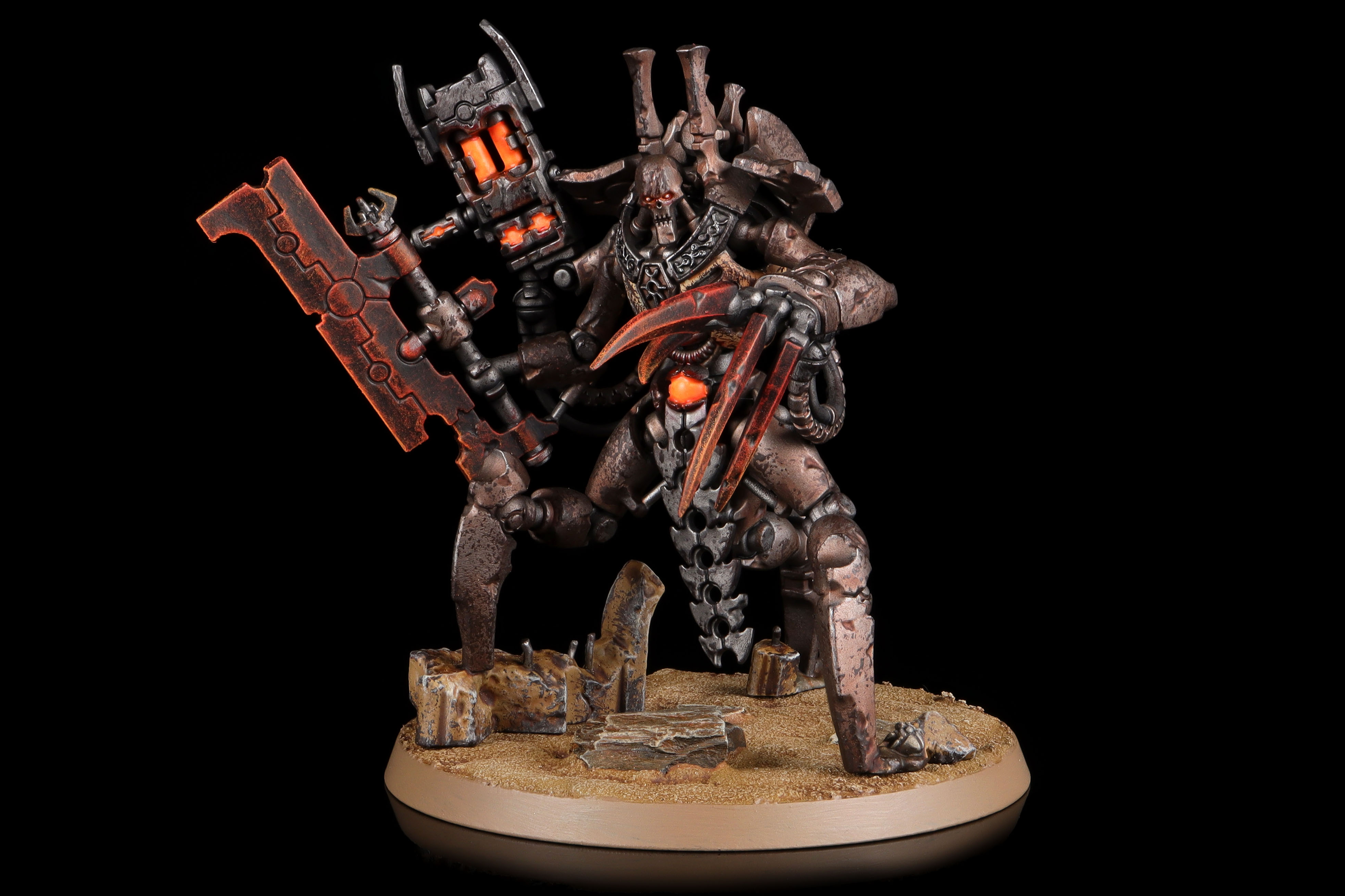
So that was a good start, and there’s plenty of good stuff to come, but first we have to talk about the Annihilation Legion, which…well it tries. Does a detachment with a very narrow set of units it applies to, and lots of rules themed around Half-Strength enemies sound promising? No?
Gunum: It does not.
On a serious note, this detachment really highlights that the rules around Below Half-Strength need a core change, in my opinion. Specifically, I think it should be updated so that a unit that’s on exactly Half-Strength counts as below rather than above. It kind of sucks that this would contradict the literal meaning of the words, but right now it sucks that it’s incredibly rare for a unit to stick around below Half-Strength for any length of time, meaning a whole bunch of rules are duds.In particular, the fact that two-model units (pretty common for light vehicles) can never be below Half-Strength is very silly.
I don’t think that change alone would fix this detachment, and if GW aren’t keen on a core change (or even on top of), this needs something like a rule that causes all units within 12” of Destroyers or Flayed Ones to count as below Half-Strength if they’re below Starting Strength. At that point, there’s probably some stuff to play with here. As is? Let’s take a look.
Detachment Rule – Annihilation Protocol
DESTROYER CULT and FLAYED ONES units in your army can re-roll their charges, and if they target any enemies that are Below Half-strength, they get +1 to the Charge.
This isn’t bad per-se, but it’s not powerful enough for how narrow it is. In an army that’s built around this, melee is going to be the way that you get enemies below Half-Strength, so tying the bonus charge distance to them already being there isn’t ideal. It also does very little for Lokhust Destroyers (an issue the whole detachment has to some extent), which is unhelpful as those are a pretty good unit!
Enhancements
Enhancement-wise, if you’re taking this detachment you’re taking Soulless Reaper 100% of the time. This can go on a Destroyer Cult unit (which is going to be a Skorpekh Lord with six friends), and means that if enemies try and Fall Back from them, you can roll a d6, and on a 3+ they cannot fall back. This is obviously excellent, and encourages you to get into the thick of it and multi-charge stuff with Skorpekh. Eldritch Nightmare is not as good for a brawling Destroyer unit, but still probably worth it – it forces a Battle-Shock test for all enemies that are in Engagement Range of the bearer’s unit at the start of the Fight Phase. Plausibly this could go on a smaller Skorpekh unit as more of a roving threat.
The other two enhancements aren’t actually locked to Destroyer Cult units, so you could in theory make some of them do a bit of work elsewhere. Eternal Madness gives the bearer’s unit Fight on Death on a 4+, which could be pretty OK on a full Lychguard unit (pending finding out where their points end up after their nerfs, as they should go down a bit). The other is Ingrained Superiority, providing an extra point of AP on a Critical Wound. This does work at range too, but Necrons don’t have many ways to fish for Critical Wounds, and often filter out quite a few Lethal Hits so the impact is going to be fairly minimal. Don’t forget that Skorpekh will usually be swinging with Devastating Wounds on key combats, so this isn’t going to help them much.
Realistically, Reaper is extremely good, Nightmare is fine and Madness is a maybe.
Stratagems
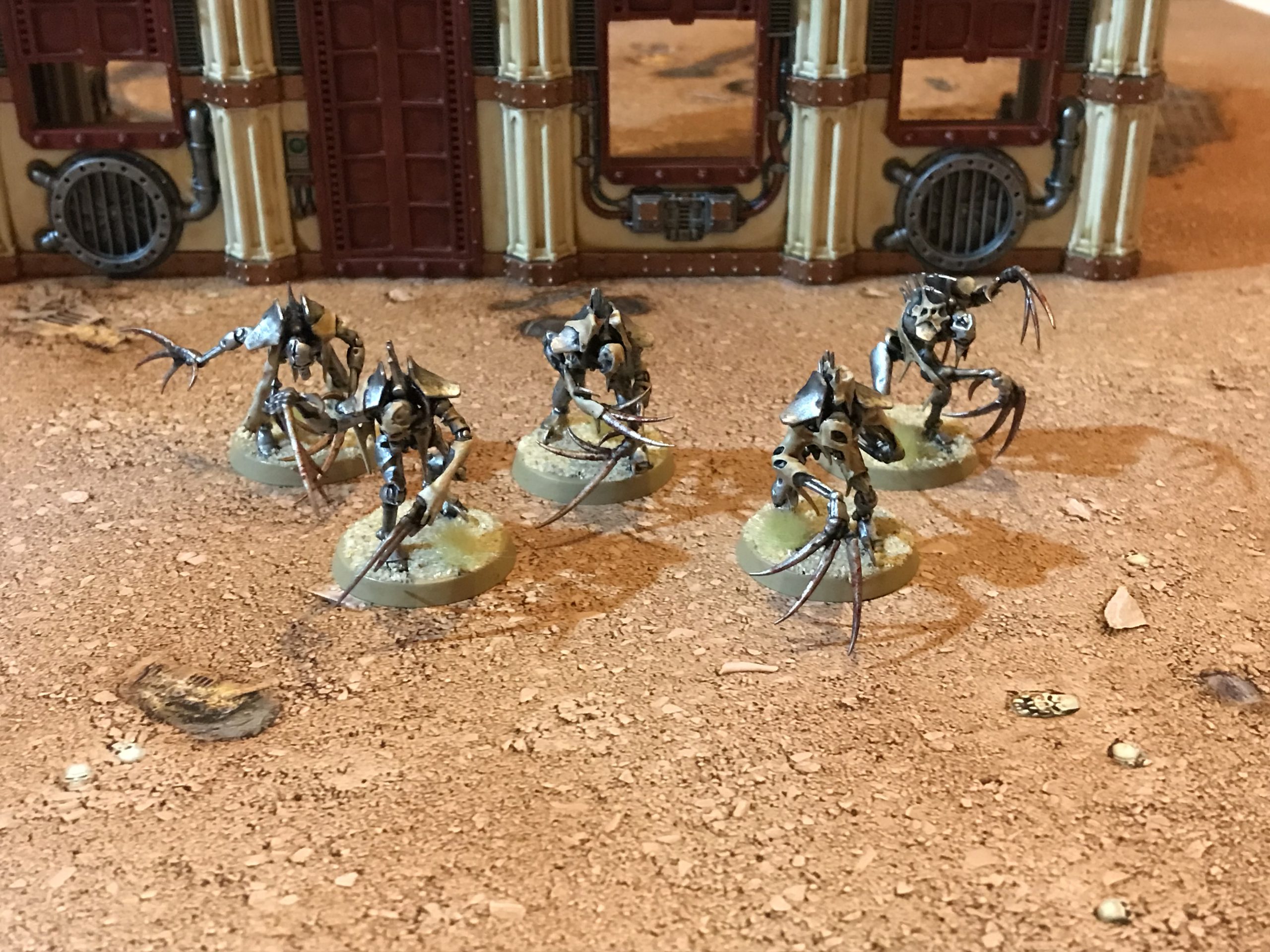
The Stratagems here continue the heavy melee focus, and all of them are locked to DESTROYER CULT and FLAYED ONE units. We start with a couple of fairly standard issue buffs – Masks of Death for -1 to hit against enemy attacks, and the Spoor of Frailty for +1 to hit against a target below Starting Strength, and +1 to wound as well if they’re below Half Strength. Both OK, but not great either – it’s a real shame there’s no return of -1 to Wound for Skorpekh, as that was key to their success in 9th, and Spoor suffers from the same thing every rule keyed around enemy Strength is, which is that it’s sometimes not available when you really need it.
Next up we have this detachment’s version of extra (Murderous) Reanimation, which is pretty cool. You can trigger this for 1CP after one of your units either destroys an enemy unit or brings them below Half Strength. Unfortunately it’s Fight Phase only, but it is still good, and a nice way of, for example, getting a few extra models onto an objective to flip it at a key moment.
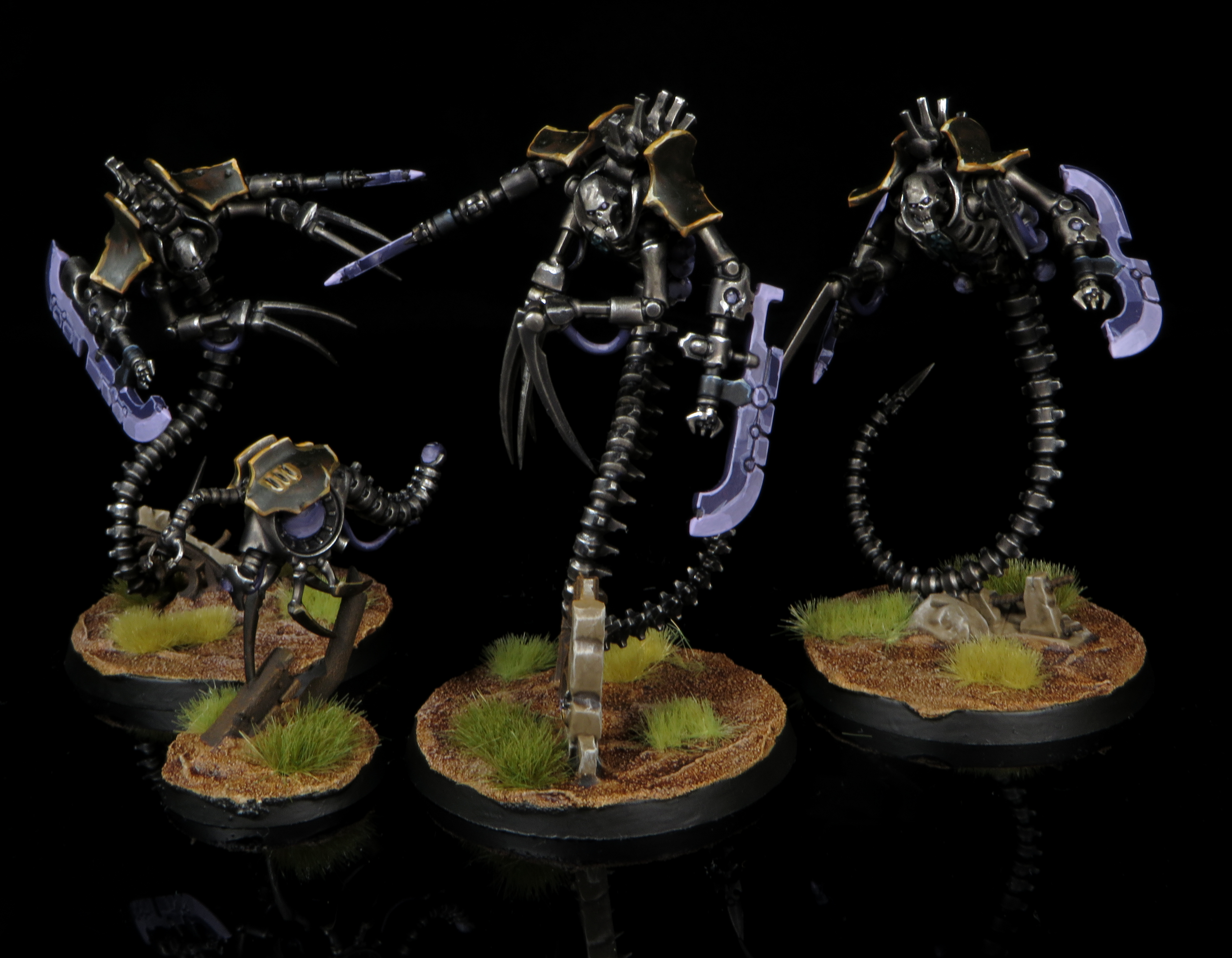
Finally, three movement tricks – two of which look incredible till you realise they’re missing a key rider. Blood-Fuelled cruelty lets you deal Mortal Wounds to an enemy and make a Normal Move (ending as close as possible) after they fall back, while Insanity’s Ire lets you make a Normal Move after an enemy unit shoots and destroys one of your models, again ending as close as possible to the unit that shot you. Sounds phenomenal – but neither provides the ability to end the move in Engagement Range, so you can’t use it to threaten to tag the opposition. The combination of that plus having to end as close as possible rather than closer really limits the utility here – you can’t tag opponents, and you won’t often be able to use it to hide your units. I suspect you’ll sometimes get a big bump out of Blood-Fuelled Cruelty, as if an incautious opponent falls back into a ruin you might be able to pursue and be out of sight, and occasionally Insanity’s Ire might helpfully shift a Lokhust unit out of danger, but these should be the slam dunks of the detachment and they’re just not.
That leaves Pitiless Hunters, which yeah you’re probably going to be slamming on your Soulless Reaper unit a lot. This gives you 6” Pile-ins and Consolidations for a phase, maximising your chance of getting everyone into touch, turning the foe into a fine paste, then multi-tagging some other stuff.
Combined with Skorpekh now hitting harder on the charge, this is basically what you’re anchoring a game plan with this detachment around, and there’s clearly some fun you can have with this set of rules, but it doesn’t feel like a complete package, and is glaringly missing some sort of support for Lokhusts, which would make it feel much more fleshed out.
Canoptek Court
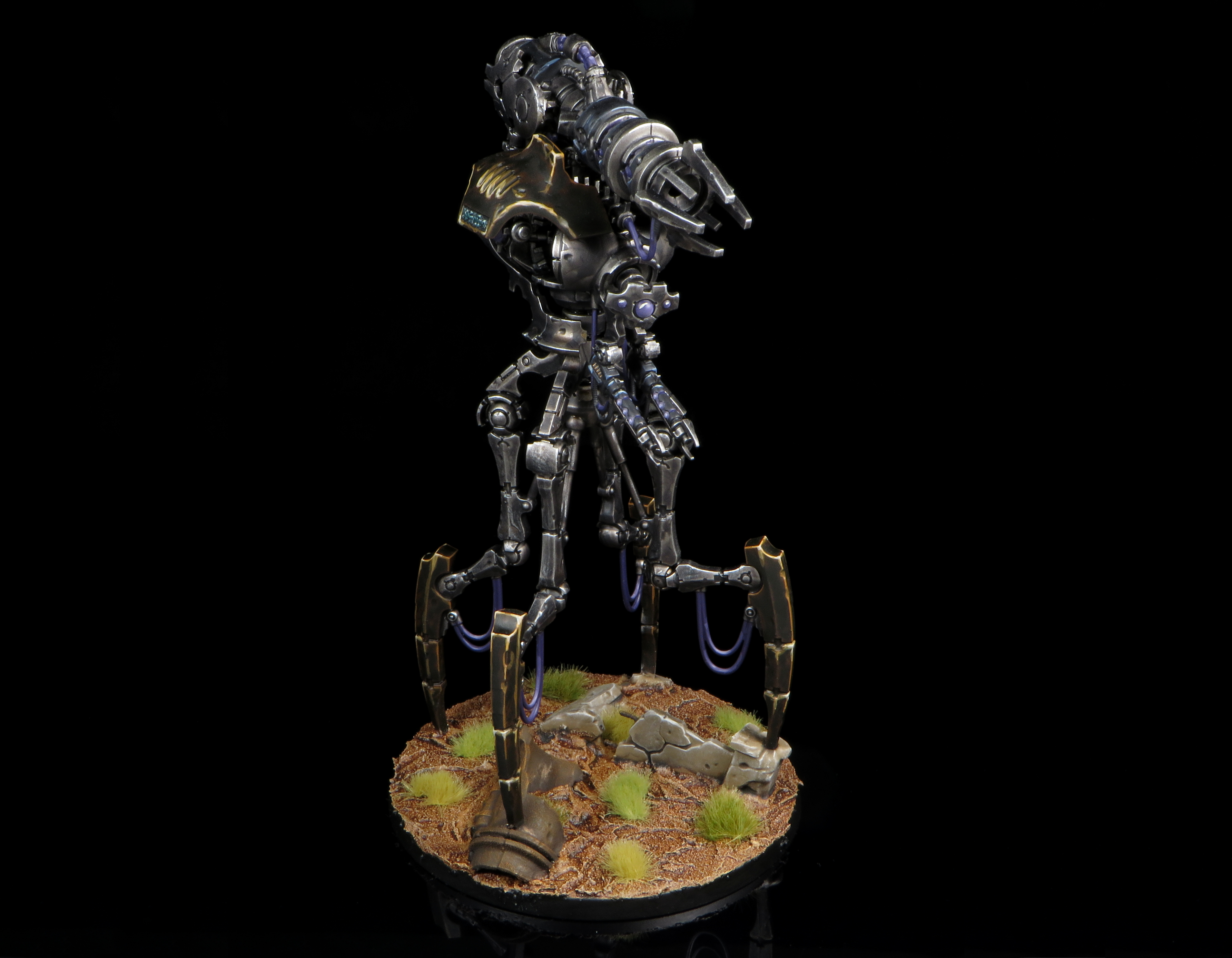
OK kids, complaining time over, the Canoptek Court rules and looks very likely to be the standout here. This is themed around CRYPTEK and CANOPTEK units, which is a reasonably broad range of stuff once you factor in Warriors or Immortals that have a Cryptek Leading them counting.
It also includes quite a few of the Forge World options that Necrons have, and while we’re not going to talk too much about them, yes Canoptek Tomb Sentinels are excellent here and yes I am mad that taking a Forge World unit as a three-of is good again. Acanthrites also swap from being a bit of a nothing burger to being genuinely decent here, so they’re worth a look.
So what makes all these robots tick? Let’s introduce the Power Matrix.
Detachment Rule – Power Matrix
When you are using the Canoptek Court, parts of the Battlefield are considered to be either within or not within your Power Matrix. This works similarly to the Shadow of Chaos in Daemons – your Deployment Zone is always in your Power Matrix, and then at the start of each Phase you check whether you control half or more of the objectives in No Man’s Land, in which case it counts as within your matrix till the end of the phase, and do the same for your opponent’s Deployment Zone.
Several other abilities in the detachment interact with this, but there’s also a baseline bonus – all CRYPTEK and CANOPTEK units in your army re-roll hits of 1 all the time, and while they are wholly within your Power Matrix this changes to full re-rolls.
This is fantastic, just an incredibly good ability, and one that works super well with almost everything it applies to. Doomstalkers, Wraiths and Tomb Sentinels get the reliability they need, big bricks of Warriors or Immortals can fish for Critical Hits, and Illuminor Szeras changes from “dangerous but swingy” to being incredibly bad-ass. The Doomstalker also suddenly gets a lot more value from its ability to Overwatch on a 5+, as with full hit re-rolls that’s far more likely to actually do something. For an army that was hurting a bit for Hit re-rolls in the Index era, this is an excellent turnaround, and you’d legitimately be able to cook up armies you’d at least consider taking if the rest of the detachment’s rules were blank.
They are not.
Enhancements

Oh boy they are not.
First up here we have the Dimensional Sanctum, giving the bearer’s unit the Infiltrators ability This whips – you’re most likely using it with a Technomancer in a big Wraith unit, as they’re fast, dangerous and now tough enough to soak most early counter-charges, but I’d probably keep an open mind about sticking it on Warriors in some games, as there are matches that are going to be blown wide open by being able to start a full unit up the board. It even helps you ensure your Power Matrix comes online mid-board nice and early. Extremely good.
Next, and honestly maybe one of the weaker ones is the Hyperphasic Fulcrum, giving re-roll 1s to Wound to a unit the bearer is leading. This is also fine on Wraiths, and may prove to be good enough to just be generically worth it on the second unit you’re probably taking. Neither Immortals or Warriors really care about this.
Third, we have a simple utility pick in the Autodivinator, which gives you a CP on a 2+ whenever the opponent gains one as the result of an ability. Slightly metagame and cost dependent, but this Detachment is CP hungry, and it’s decent to throw in if you don’t want to take Imotekh.
Finally…ah old friend, you’re back. The Metalodermal Tesla Weave returns, allowing you to zap an enemy unit that picks the bearer’s unit as a charge target for Mortal Wounds on a 2+, once per phase. Did I nearly have an existential crisis after rolling a 1 on this five times in a row at a 9th Edition GT? Yes. Is it still good on paper and something you should take? Also yes. This feels good on the Plasmancer Immortal unit that you’re almost certainly taking for reasons we’ll shortly get to, helping keep them alive to do their thing.
A good selection all-told, and I can and will make use of all of them at various times, and can’t imagine running a list without the incredible potential haymaker of Infiltrating a full block of Wraiths or Warriors.
Stratagems
There’s a mix here – some of these apply to CRYPTEK and CANOPTEK units, some are CANOPTEK only.
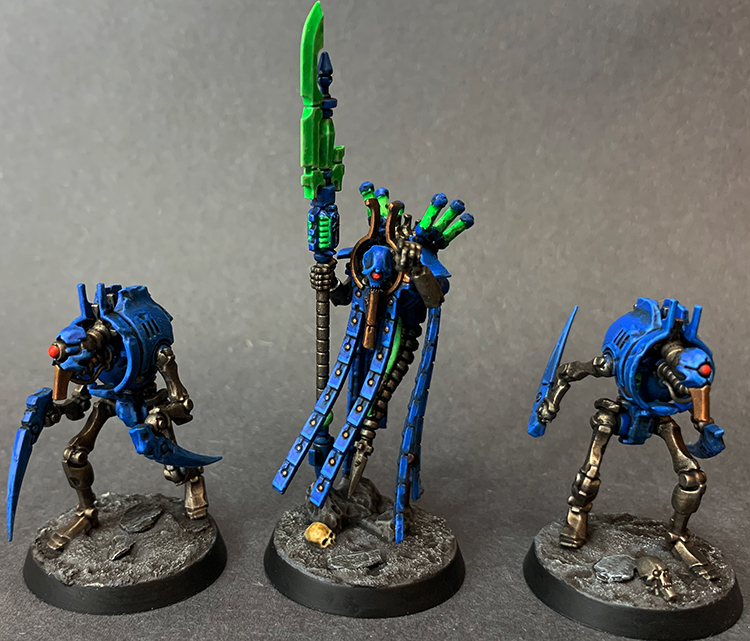
Let’s get the big one for both out of the way first. Cynosure of Eradication is this detachment’s lone 2CP offering, but it’s incredibly potent and, crucially, a Battle Tactic, so eligible for free use off an Overlord. You use this at the start of the Phase, targeting a unit that’s wholly within your Power Matrix (which you’re obviously going to do after checking where it has extended to), and it just straight up gives your unit Devastating Wounds till the end of the phase. Now, consider, if you will, a unit of Tesla Immortals with a Plasmancer shooting at a target on an objective. Thanks to the Power Matrix they have full hit re-rolls, so can fish for their Sustained Hits 2 on the Plasmancer’s 5+. Thanks to their inbuilt ability, they have full Wound re-rolls with which to fish for Devastating. Put it all together and you’re expecting 11 damage-worth of Devastating Wounds (plus probably some extra from the Plasmancer’s improved Mortal Wound effect), delivered at enormous threat range if you use the new Teleport Overlord, all activated for free thanks to its Battle Tactic-ness. We’ll see how this plays out in practice, but if anything is going to end up catching nerf a few months down the line here, it’s this. It’s also pretty good in the Fight Phase on a Wraith unit with the Hyperphasic Fulcrum.
That’s far from the only treasure in here too.Curse of the Cryptek is pretty cool if you’re running Doomstalkers and Sentinels, triggering after an enemy unit destroys a Cryptek from your army. For the rest of the game, all your Canoptek stuff has +1 to Hit and Wound against it, which is going to make it turbo-dead in short order. Great to squeeze some last value out of a Technomancer who has been running amock with some snake friends.
Another returning classic next in Solar Pulse, which lets you pick an objective within 18” of a Cryptek at the the Shooting Phase and get Ignores Cover against enemy units within range of it for that phase. The bonus isn’t actually locked to CANOPTEK or CRYPTEK units, but realistically you’re going to get the most value from this via a big brick of Warriors with Szeras’ AP bonus, suddenly reliably hitting for AP-2 chip damage. Certainly valuable in some situations.
Next, remember those Wraiths? That you infiltrated? That your opponent is maybe trying to Charge? Hope they didn’t end a move within 9” of them, because if so you can use Reactive Subroutines to make a Normal Move of up to 6”. This ability whips wherever it appears, and yeah it sure is good here. It works for any Canoptek unit, so it’s also another reason why Acanthrites might have serious play in this detachment, as they’re very brittle in combat, but start looking like great value if they can dodge it.
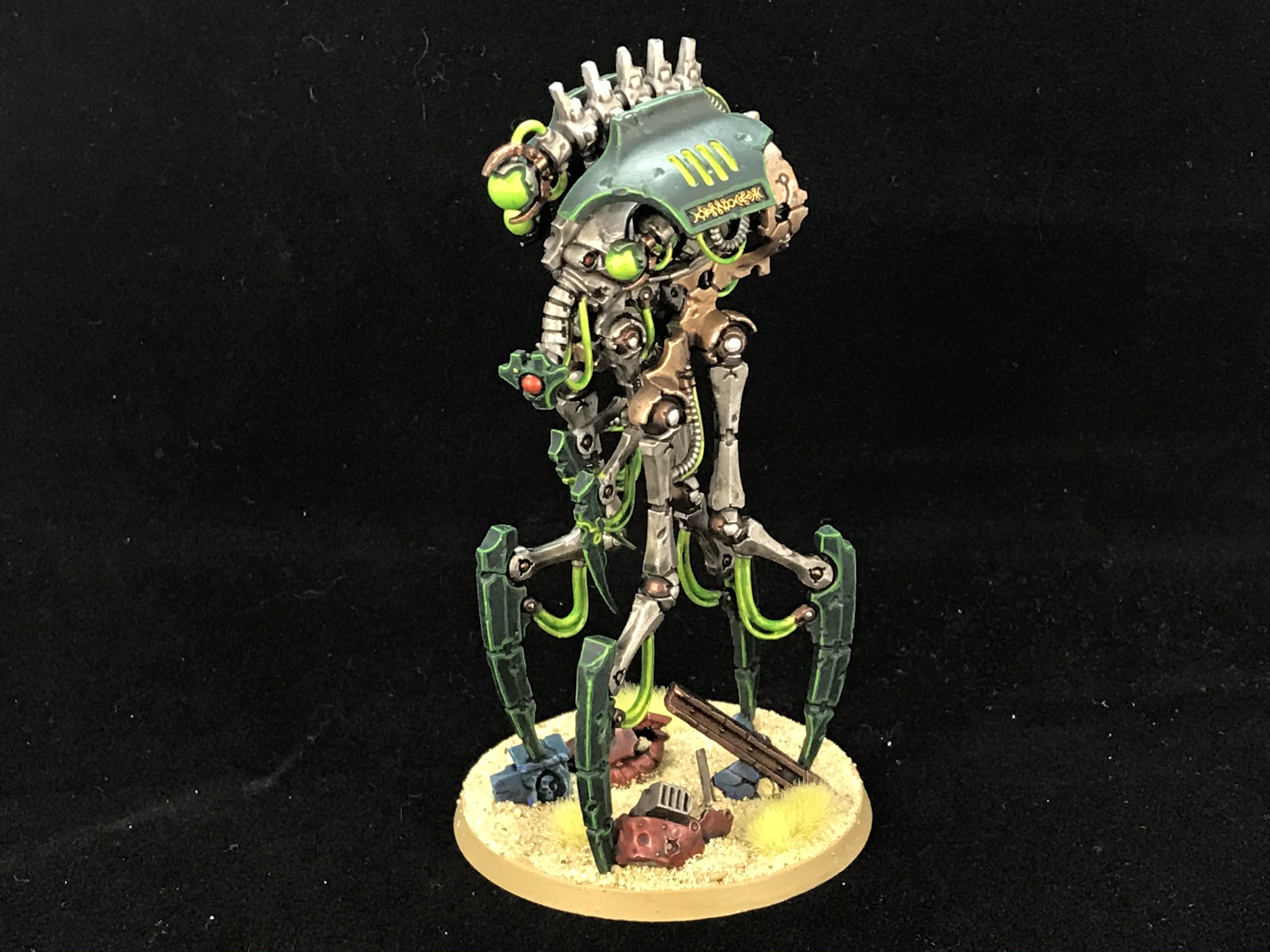
Continuing the theme of keeping Canoptek stuff safe, Countertemporal Shift gives this detachment to another trick that’s juicy wherever it appears, letting you make a CANOPTEK unit unshootable from outside 12” when it’s targeted. Great for keeping the Reanimator safe now it has to stick closer to the front lines, and great for preventing reprisals against a Doomstalker, making them very handy for home objective babysitting.
Finally, this detachment also gets a unique Reanimation trick, using Suboptimal Facade to activate a CANOPTEK unit’s protocols when the enemy declares a Charge on it. This is a bit less good than other, similar abilities just because d3 wounds is generally going to mean less to these units, but given how strong the Stratagems are here overall it’s kind of fine to have something situationally useful.
Really, there’s not much more to say here – this detachment whips, it’s a clear favourite to be the best out of the book, and should be a blast to play. Zero prizes for guessing what I’ll be running out at the first event I play with this book.
Obeisance Phalanx
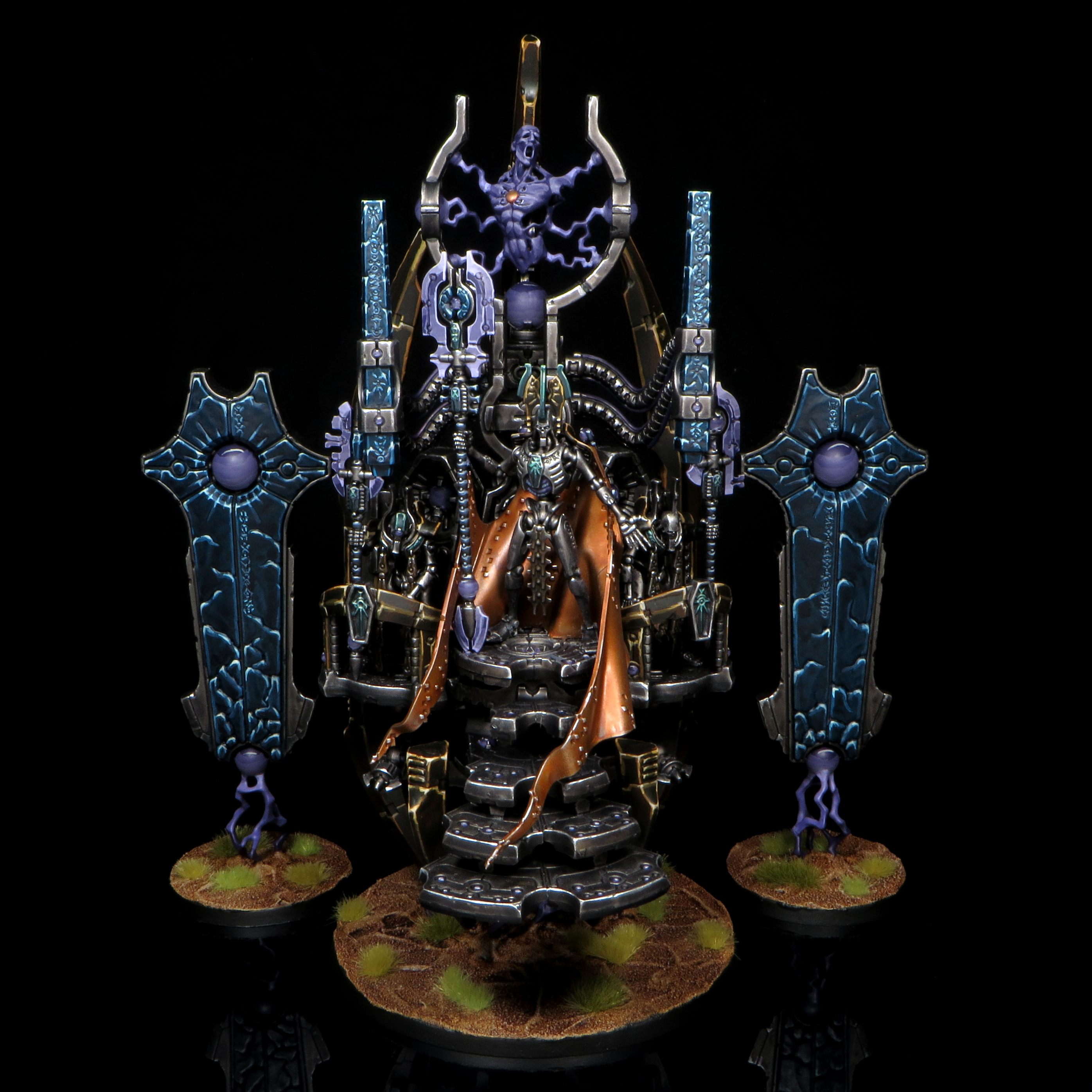
We’ve had the mad scientists, now for the ultra-elite of the Necrons. This detachment centres around TRIARCH, LYCHGUARD and OVERLORD units, the last bit meaning that once again you can deploy some of this stuff to great effect on Warrior and Immortal units too. There is one weird thing here that we’re thinking may get FAQed, which is that Imotekh, Trazyn and the Catacomb Command Barge don’t have the Overlord keyword this edition, so may not get the full benefit here. You quite plausibly want to stick them with Lychguard here anyway, so it isn’t the end of the world, but it’s a bit weird for Imotekh in particular given his fancy new stature.
Oh, it also doesn’t include Szarekh which again – intentional? Not intentional? Maybe he’s scary enough already!
Detachment Rule – Worthy Foes
The Necron elite focus on surgically eliminating key targets. In each of your Command Phases, you can pick one enemy unit, and your units with one of this detachment’s relevant keywords get +1 to Wound against it till your next Command Phase. This is obviously powerful, and helps Lychguard in particular punch up to take on serious threats. It also makes massed firepower from Warriors or Immortals a serious consideration, and really helps Triarch Praetorians get some play. People were already somewhat sleeping on the voidblade/caster build (until last weekend when a unit of ten made the top eight at WCW), and unleashing a bunch of rules that don’t depend on having Leaders seems great.
Enhancements
All four of these are Overlord only, and realistically two stand out. Eternal Conqueror is the first, giving your unit full hit re-rolls against enemy units within range of an objective. Simple but brutally effective, and a great combo with Warriors and the Enslaved Artifice Stratagem to fish for Criticals on a 5+ – no Plasmancer needed! The other is the hilarious Honourable Combatant, which does something we’ve not seen before. When your Overlord’s unit destroys an enemy Character, your opponent loses a Command Point if they currently have any. Now, if I’m honest I think it’s more likely that I’ll be “honourably” cutting down enemies at range in a hail of Tesla fire, but this can be huge into some matchups, and isn’t something people are going to be used to playing around.
For Overlords who want to get a bit more into the mix, you have Warrior Noble and Unflinching Will. Both provide benefits in a Fight, and honestly I keep getting the names the wrong way round, because Noble is the defensive one, giving -1 to hit against the Character’s unit in melee, while Unflinching is offensive, giving the Character Precision and Anti-Infantry 5+ in melee (which looks odd till you remember that all the weapons they can take have Devastating Wounds). Both seem plausible with either Lychguard or Immortals – the former to stack toughness when they’re in the thick of it or pick off enemy buff models, the latter to help survive a charge or take advantage of (sometimes) full Wound Re-Rolls in melee to fish for Criticals.
Stratagems
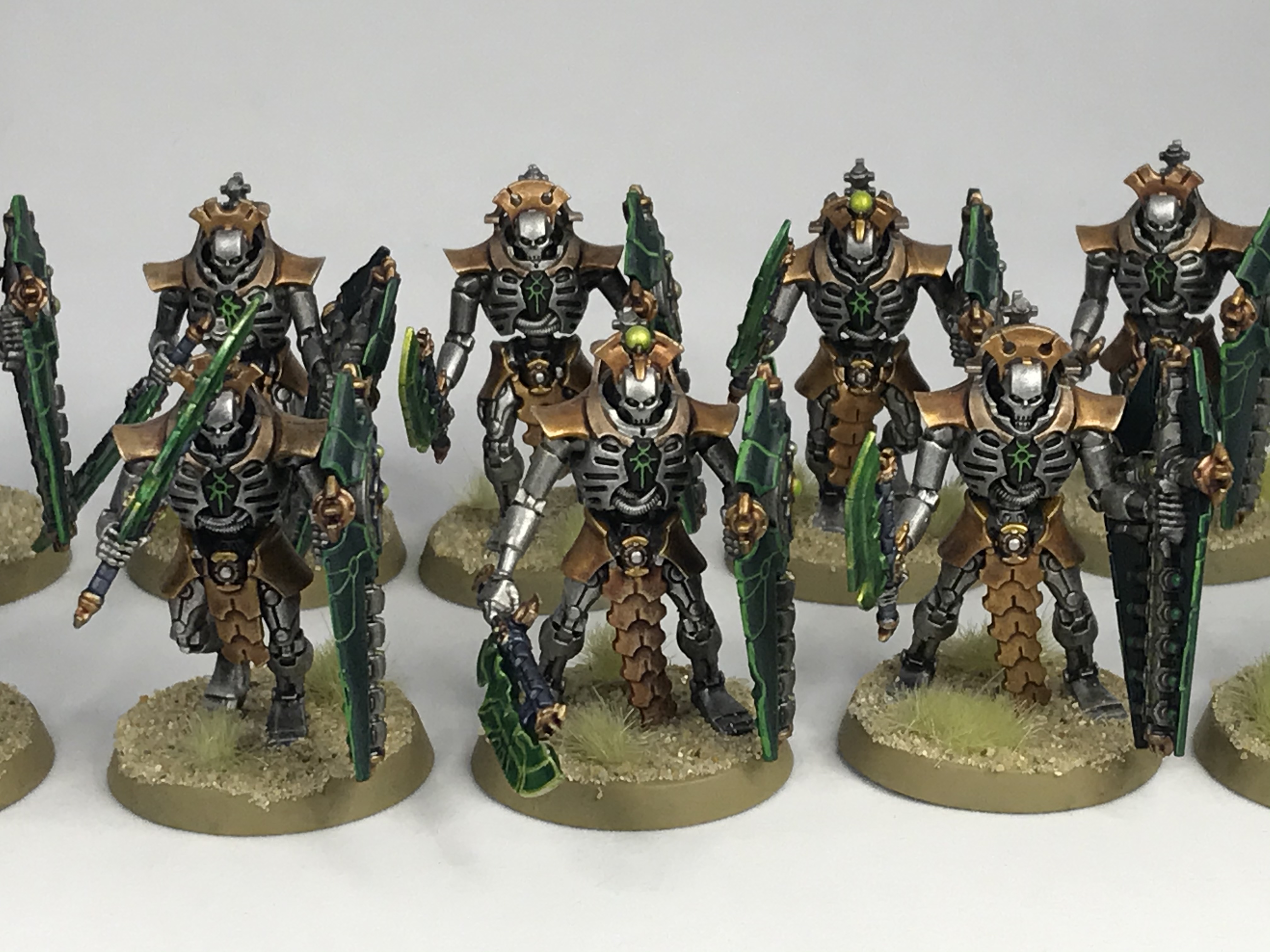
A bit more of a mix in terms of eligible targets here – some are locked to LYCHGUARD and TRIARCH units, both others are a bit broader.
A cool thematic one to start off with is Your Time is Nigh, which you can activate as long as you can target your Warlord with a Stratagem at the point the opponent’s Warlord dies. After that, all opposing units suffer a -1 to Battle Shock and Leadership tests for the rest of the game. This isn’t actually that good but it’s cool enough to get a pass, and I guess Psychomancers got some healthy boosts, so you could work with that.
Next up is Enslaved Artifice a strong output boost for anything with Critical or Sustained hits, giving Critical Hits on a 5+ when a unit (non-Titanic, so no using it with tesla orbs or Monolith death rays) Shoots or Fights, with no keyword limitations. This is good on a unit of Warriors you’re giving full Hit Re-Rolls with Eternal Conqueror, but is also decent with Lokhust Destroyers and Enmitic Lokhust Heavies, as it lets you skip on a Lord and still get the juicy 5+ Critical Hits. The detachment also provides a really good boost for any Vehicles in Nanoassembly Protocolsb, giving you -1 to incoming Damage for a phase for a mere 1CP. This is obviously really good with the Silent King, making him exceptional here, but it’s decent just for protecting a solo Doomsday too. It’s also worth at least thinking about a Tesseract Vault or Monolith with this, and ironically this might be enough of a lure to make this a better detachment for running a Monolith than the next one, which is themed around them.
Those are the really cool ones here, and ironically the three exclusive to Lychguard and Triarch are more situational than universally great. Variously, these can provide Fight on Death on a 4+, Precision in melee for a phase or +1 to OC (activated in your Command Phase). None of these are bad things to have access to, but they’re also things you could very much go a whole game without ever calling on.
All in all, I think there is enough stuff here to build a compelling plan around, and it helps that it pulls in a very different direction to the Canoptek Court in terms of the units it supports. It does also seem plausible that the Silent King going aggro with -1D is such a nightmare that he carries this to the top tables by himself.
Hypercrypt Legion
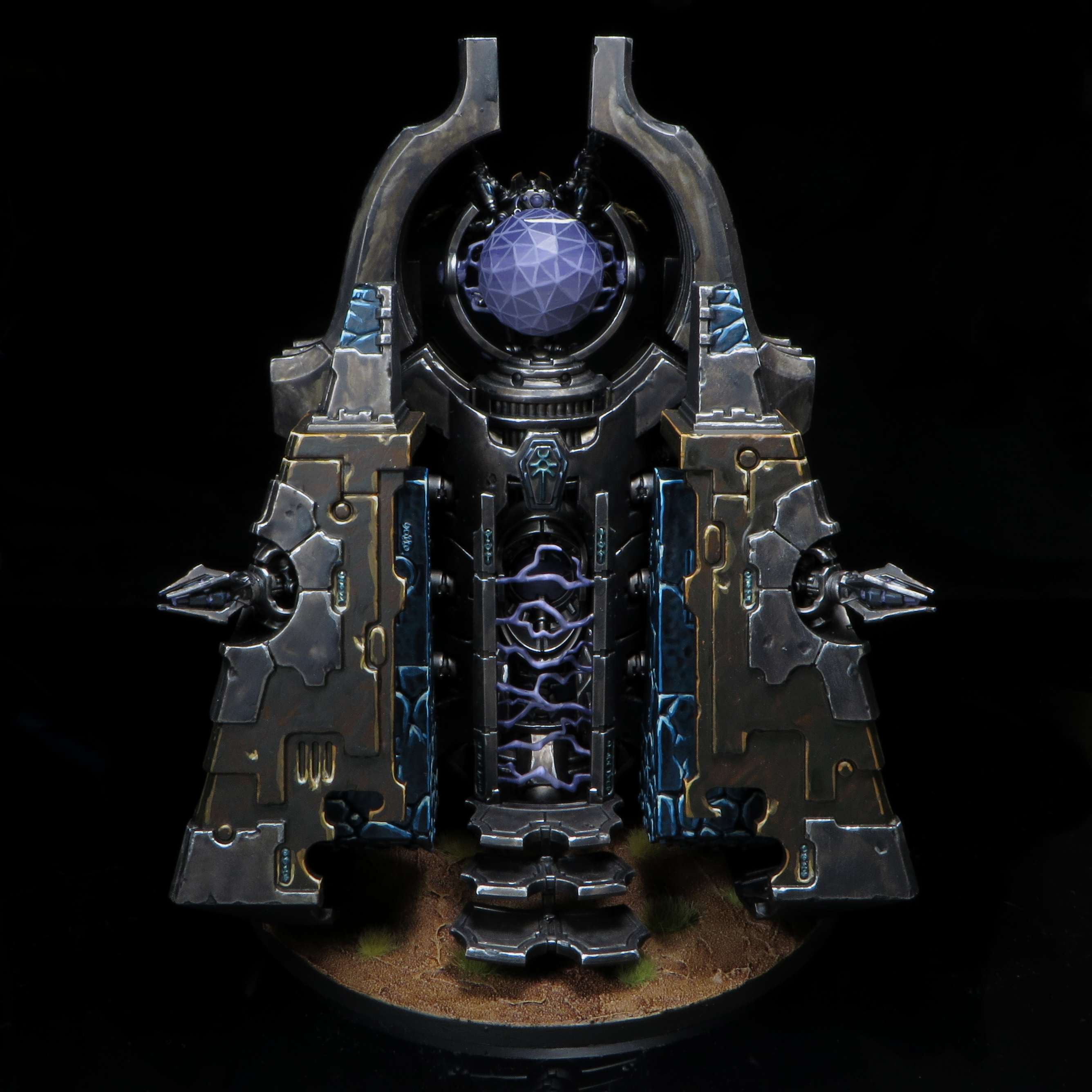
To round out the selection for our favourite skeletons, we have the Hypercrypt Legion, which is themed around Monoliths and teleporting, the latter making it a particularly great place for C’tan. This is clearly not a surprise to whoever was compiling this book, as the banner image for this is a really cool picture of the Void Dragon.
Detachment Rule – Hyperphasing
What if Necrons were Grey Knights? Let’s find out – with this ability, at the end of each of your opponent’s turns you can pull a number of your units (2/3/4 depending on Battle Size) that are not in Engagement Range of enemy units into Strategic Reserves, ready to appear and cause some mischief shortly afterwards. Do note that this isn’t exactly the same as the Grey Knights rule – your units pull into actual Strategic Reserves, so unless you have Deep Strike (or use the Cosmic Precision stratagem) you’re limited to the setup rules for that, and also can’t use this to redeploy a unit turn 1 if you go second. The flip side, of course, is that if you decide you want to keep your units in reserves for more than one turn, you can.
This ability is really, really good, and completely transforms how you can play Necrons, particularly in combination with some of the other things the Detachment provides. It’s great with some units in particular too – both Lokhust Destroyers and C’tan often struggle to consistently line up their positioning, and the latter have a really rough time with Night Spinners, and this completely changes that dynamic. The Nightbringer seems particularly funny to use with it, for reasons we’ll get to, but going full C’tan spam in this detachment with their massively boosted durability seems very real. It does also mean the Monolith has fewer issues with terrain on denser maps, as you can just keep teleporting it (and since it has native Deep Strike, it can use it when it comes in).
Enhancements
The two key ones here are Arisen Tyrant, giving hit re-rolls of 1 to a unit all the time or full re-rolls if it was set up on the Battlefield this turn, and Osteoclave Fulcrum, which gives a unit Deep Strike. The former is very good with Heavy Lokhusts with a Lord, and you can combine both in a single big unit of Warriors, probably with an Overlord and Plasmancer, for a big power play.
The other two seem like they could be somewhat redundant. Dimensional Overseer lets you pull one additional unit each turn with Hyperphasing, which honestly might just be overkill a lot of the time, while Hyperspatial Transfer Node lets the bearer’s unit auto-Advance 6”. That’s not bad, but you can also just take a Teleport Overlord and you just have this. Plausible that you might put this on a Hexmark or Psychomancer to be a speedy utility guy I guess.
Stratagems
OK look – they really want you to use a Monolith with this detachment. Four of the Stratagems here either must be used with a Monolith or are clearly intended to be.
On the “intended” side we have Quantum Deflection, giving a Vehicle a 4+ Invulnerable Save (which basically only the Monolith and Planes don’t just have by default) when attacked and the more unique Entropic Damping. The latter is activated when an enemy unit targets a TITANIC model within 18” a unit, and makes all the weapons in the attacking unit Hazardous for the phase. Now, this is very funny but isn’t going to do that much a lot of the time, and hilariously what would be the single best target for it (Crisis Suits) are already going to be Hazardous when they’re shooting you. Answers on a postcard as to whether there are any other units out there which are firing enough guns at once for this to have a reliable impact (remembering that you can CP re-roll a Hazardous test if it really matters). Grey Knight Purifiers I guess? Ultimately neither of these move the needle that much – the 4+ is certainly nice to have access to, but you’d probably rather have the -1D from the previous detachment, as most of the time your armour save is going to be 4+ or better in shooting. Helps if Angron is trying to trash you I guess.
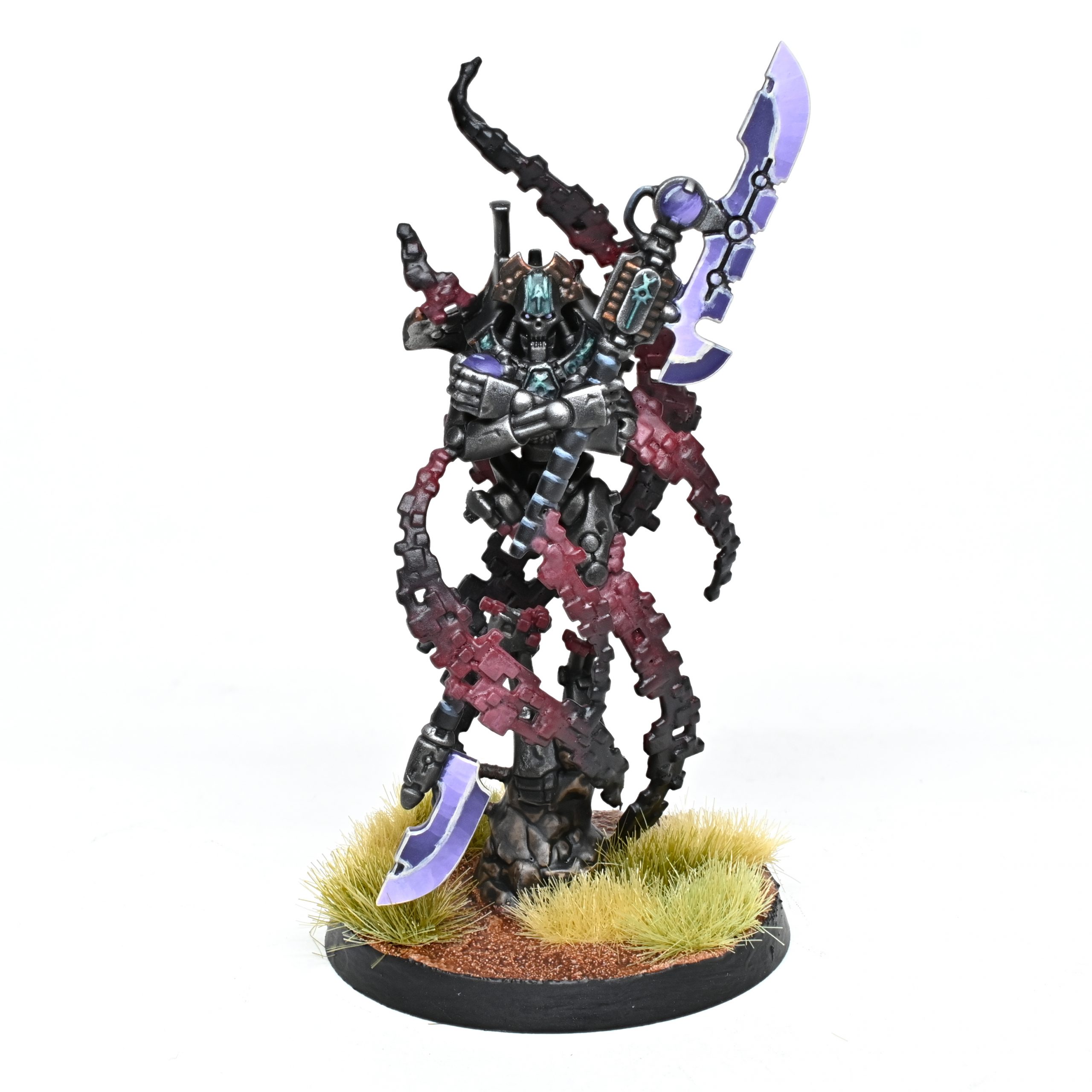
Next up the actual, literal “you must have a Monolith” ones. These are both undeniably very potent, but also both cost 2CP, and I think it would be pretty reasonable for Stratagems that require you to have a gigantic, expensive model both in your army and alive to use at all to cost 1CP. They are, at least, both great as mentioned, one letting you teleport an Infantry unit to a Monolith after they lose a model, potentially saving them from further harm or maybe messing up objective maths, and the other letting a unit that deployed using the Eternity Gate to charge this turn, effectively providing an automatic charge most of the time. Clearly the option of ramming some Skorpekh or Lychguard right into the opponent’s face on a go turn is pretty excellent.
Finally, two broader ones that lean into what the detachment is aiming to do. The first is Reanimation Crypts, which you use in your Command Phase to trigger Reanimation Protocols for all Necron units that are currently in reserves (which they normally wouldn’t get to). How does reanimating a multi-model unit work in Reserve if you can’t “set up” the new models? I expect some premium rules discourse as we, the community, explore this together, but really what you’re interested in here is making sure your C’tan still get to heal as you’re redeploying them.
Last, but very much not least, and the thing that helps pull everything together, is Cosmic Precision, which lets a unit that’s arriving from Deep Strike or via Hyperphasing set up anywhere on the Battlefield that’s more than 3” from any enemy units. The specific mention of Hyperphasing is important, because it would appear to override the normal Strategic Reserves limitation for units that don’t have native Deep Strike that are using it. This lets you do some very funny stuff – use it on 20 Warriors and you might actually be able to straight up encircle an enemy Lone Operative – not for any real reason, just vibes. More practically, you can put a Monolith right in the opponent’s face, or drop the Nightbringer amidst the enemy, allowing their Mortal AoE to start reaping souls in the FIght Phase. There’s endless stuff you can do with this, and its ubiquity makes the fairly limited scope of some of the other Stratagems sting a bit less – you’re going to spend a lot of your CP on this.
Once again, it feels like there’s enough here to put some interesting and unique builds together – the fact that it goes so hard on Monoliths is a little bit of a shame, as I’m not actually certain that’s the way to go with it, but I’m a man who loves C’tan, and the thought of just hurling them around the board is definitely appealing.
Datasheets
One cannot build an army on Detachments alone, and the other key ingredient is, of course, units. Necrons have a fairly extensive range of datasheets, even after the removal of some of their older Characters, so there’s plenty to cover here. In addition, even for those familiar with the Necron Index there’s quite a bit of novelty here – like with the detachments, the proportion of changes from the Index is significantly increased from the previous two books.
We’re not going to dive deep on every single unit, and are instead going to highlight:
- The new Datasheet (there’s just one this time).
- The updated Datasheets, both upgrades, downgrades and sidegrades.
- Any other Datasheets with significant new uses thanks to the changes to detachments.
For Necrons, the last two categories are going to blend together a bit because a lot of the units that see the biggest impact from the Detachments have also seen some sort of change. Let’s get into it.
New Datasheet
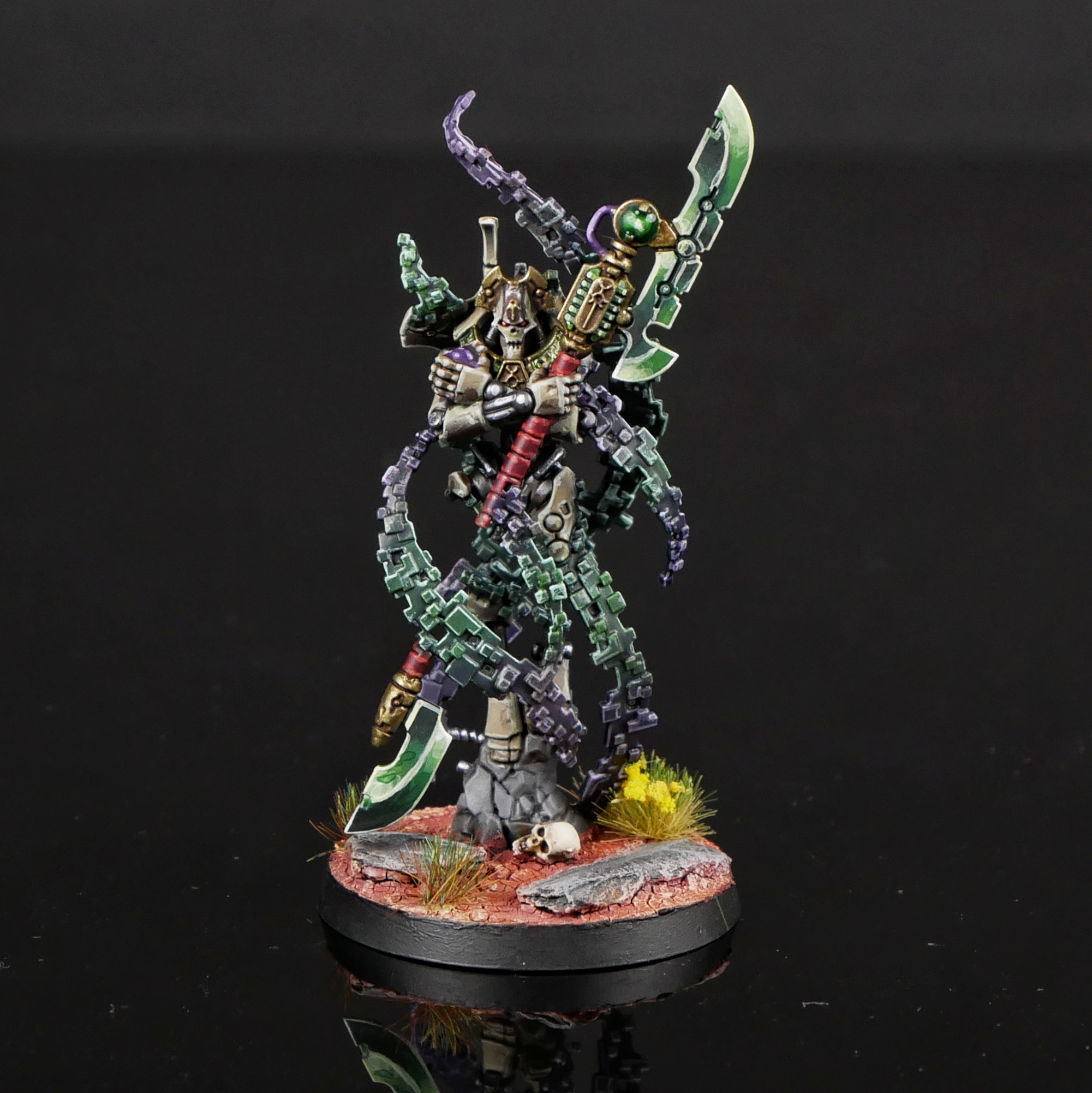
Necrons get one (1) new Datasheet – a new flavour of Overlord, specifically one wearing a Translocation Shroud. He comes with the standard My WIll Be Done ability for a free Stratagem (a Battle Tactic after the Dataslate) once per Battle Round and a standard Overlord’s Blade melee profile and Resurrection Orb. His unique trick comes from the Shroud – this means that when his unit Advances, they automatically move the full 6”, and in addition they can move horizontally through enemy models and terrain when making any of the three kinds of Movement Phase move.
This is good, and unless the vanilla Overlord is a lot cheaper once the points land, there’s very little reason to take one over this. Mobility is a classic Necron weak point, so being able to add it via a Character is excellent. It’s particularly good with Tesla Immortals, since their weapons are natively Assault. Expect to need one or two of these in your collection.
Updated Datasheets
Right, here’s the meat, because there’s a bunch of stuff updated here. At an army level, there are uniform changes to:
- Resurrection Orbs: which now provide a once-per-game Reanimation at the end of any phase.
- Movement speed: Infantry baseline is still 5”, but there was a bunch of stuff in the Index that was 1” slower than it used to be. That’s been discarded – a lot of mid-weight stuff gets +1” move here, which is pure upside. The exception is C’tan, who all go down by 1”, though as we’ll see in a second they get some bonuses to compensate. In fact…
- C’tan Shards: All three named C’tan plus the Transcendent now have a native 5+ Feel No Pain. This is hilariously strong, as long as you can get them into touch. It’s not quite as good as the 4+ was on the upgraded Transcendent in the Index but the massively higher damage potential of the Nightbringer and Void Dragon makes up for that. Also, spamming Transcendents could at least be considered now.
- Particle Weapons aren’t (almost) all BS2+ any more. Why were they before? Who knows!
The rest of the changes are more unit specific, so let’s start with the really good stuff.
Upgraded
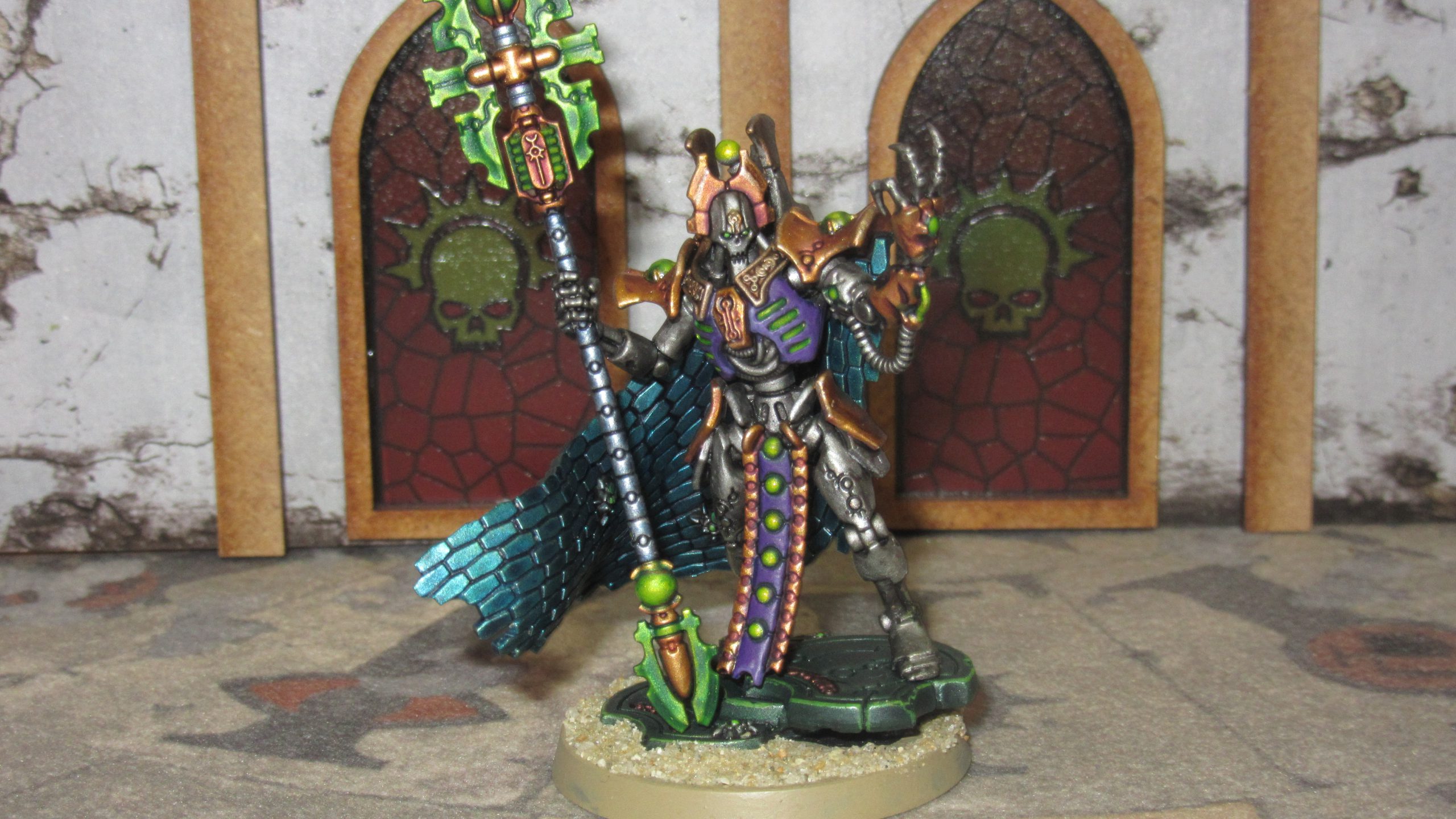
May as well start at the top – both Imotekh and Szarekh get some improvements. Imotekh’s is pretty simple – his new, larger stature is reflected by one more wound. That’s all, and that’s kind of fine – he’s still a great CP battery, and if you run him in the standard Awakened Dynasty, it’s much easier to reliably trigger his Lord of the Storm in the midst of the foe thanks to the change to the Character resurrection stratagem. Szarekh, meanwhile, could maybe be argued as a sidegrade but realistically ends up as a buff – his best offensive aura, the re-roll 1s to hit and wound, now applies both at range and in melee, which really pushes up his flexibility and bullying potential. He also gets an improvement to his “pure melee” boost, adding +1S as well as the existing Charge re-rolls,.You still probably only pick that if you have lots of long charges to make, but an upgrade is an upgrade!. He also now just gets a flat Ld buff instead of un-shocking someone, and he’s one of the units that gets +1” to their movement (though notably loses FLY). Given the strong support for him in several of the detachments, expect to see him out and about a lot in the wake of this codex

Elsewhere in Leaders, there are substantial improvements to the abilities of the Plasmancer, Royal Warden and Psychomancer. The Plasmancer’s Lethal Hits on 5+ remains and is generally far more relevant now, thanks to better access to hit re-rolls, and their Living Lightning Mortal Wound effect also improves substantially, now rolling 4d6 against an enemy unit and dealing a Mortal for each 4+. This is flatly better against any target that has 11 or fewer models, and the fact that it can chip some Mortals on anything is a big deal. It’s also not a shooting attack and has 18” range, so can sometimes pull a clutch snipe on a Lone Operative who is just out of reach. Expect to see a lot more of these, especially in the Canoptek Court and Hypercrypt Legion detachments.
The Psychomancer also gets a big glow up, to the point where you’d maybe sometimes try and work one in. Their Nightmare Shroud now forces any enemy unit within 6” that’s below Starting Strength in the opponent’s Command Phase to take a Battle-Shock test at -1, and their Harbinger of Despair ability to force a Battle Shock can be triggered at the start of any of the phases in your turn, not just shooting and applies -1 to the test. Crucially, this means that you can force an extra hard Battle-shock test on the enemy prior to objective control being evaluated in your turn, which can create some big swings. Obviously the base they were starting from is a lot lower than the Plasmancer, and the Psychomancer still suffers from competing with other Cryptek flavours for a slot in a unit, but there’s clearly an attempt and I’d at least consider taking a solo one as a utility piece.
The last big Leader change is to the Royal Warden – gone is the Assault/Heavy buff, replaced by the glorious return of the ability to Fall Back and shoot. This is huge – getting stuck in combat forever is a failure case for Warriors, so removing that threat is great. I already quite liked these as a cheap way to add some shooting and a Leader to Warriors, now I love them. Last up for the commander buffs is a simple but welcome one to Skorpekh Lords, gaining an extra wound, making their profile to stature ratio slightly less disappointing.
There’s one more Leader that gets sidegrade changes that need to be mentioned now – the Technomancer. The Control Node version of these is just gone, so they’re always rolling with the Canoptek Cloak. The bad news is that they lose Lone Operative. The good news is that they can now join Canoptek Wraiths as a leader and oh buddy, let’s talk about Wraiths. These have been excruciatingly close to being good enough in the Index, but now they gain a fourth wound each and the ability to both have a Leader, important for both the Awakened Dynasty and Canoptek Court, and get a 5+ Feel No Pain from them. This catapults them massively over the line to being one of the best units in the book, with the only tiny drawback being that their Particle Caster gun option gets corrected down to BS4+. Who cares – you’re re-rolling hits or at +1 to hit in the best detachments for them. The rise of Wraiths distinctly softens the blow of the durability of the Lychguard brick dropping, and these are going to be a full-blown staple.
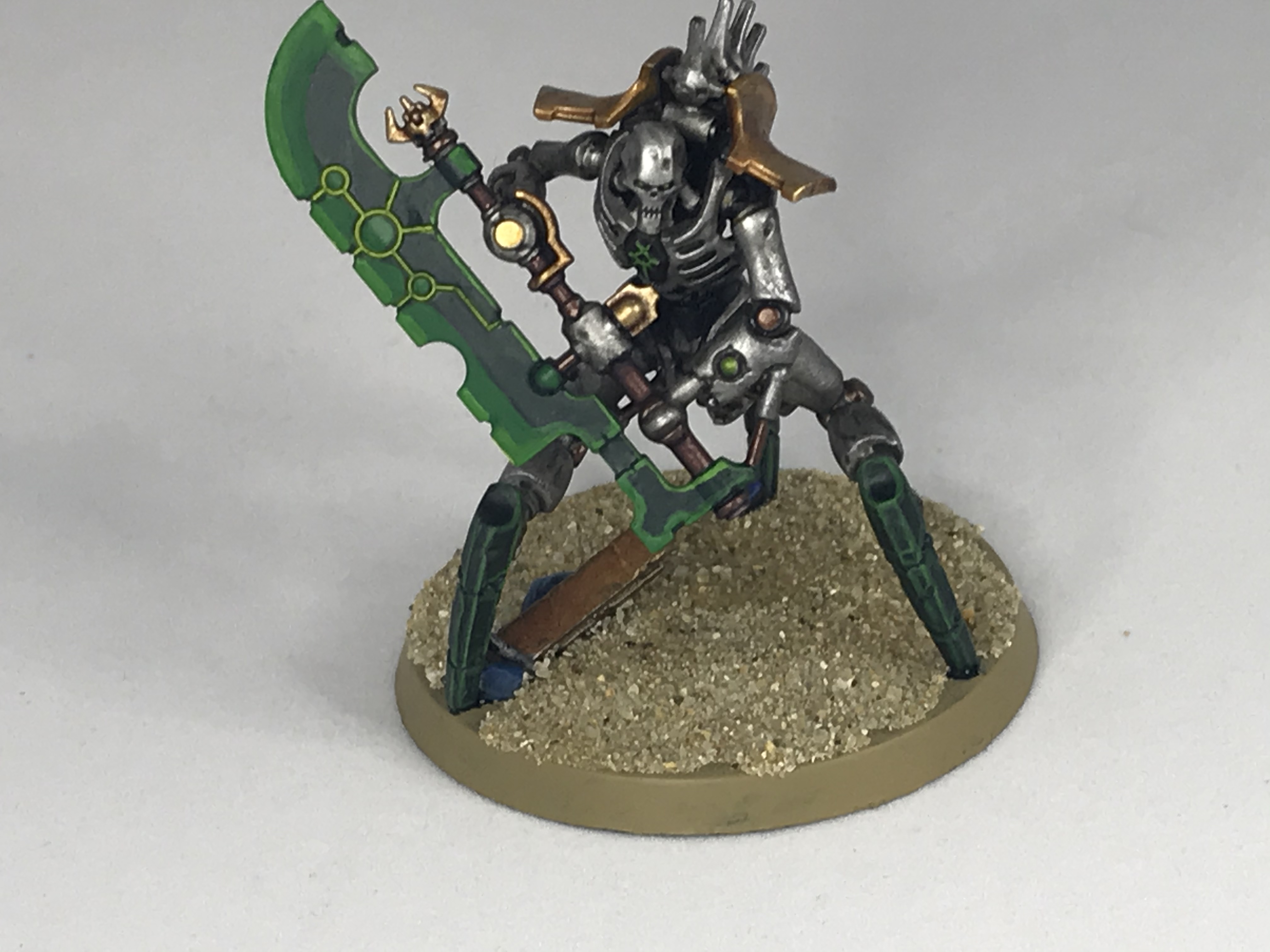
Fans of chopping stuff will also enjoy improvements to the Nightbringer and Skorpekh. The Nightbringer’s change is pretty simple – as well as gaining the common 5+ Feel No Pain, the big swing of their scythe now deals d6+2 damage rather than d6. This is very helpful, as it amps up their reliability into stuff with 3W, and makes them trash Redemptors and Armigers with consistency. Skorpekh also get more reliability – Whirling Onslaught, which used to provide a largely irrelevant immunity to WS debuffs, instead gives you re-roll 1s to hit all the time, and full hit re-rolls on the charge. Vastly superior, and works well with the Skorpekh Lord’s Lethal hits to boot. Skorpekh still slightly struggle for a role in this book, but this moves them towards a place where they’re OK as a counter-charge piece.
Not to be outdone by their melee cousins, Lokhusts get a buff too. They still get re-roll 1s to hit against the closest enemy unit, but this now improves to full hit re-rolls if the target is on an objective. This combos very well with Lethal Hits on 5+ when they have a Lord, making them great all-rounder shooting threats, and some of the new mobility tools work great with them too. I think it also moves a unit of three as a troubleshooting piece to hold in Strategic Reserves towards being actually worth it – they’ll now pop on and reliably punk a Lone Operative that’s chilling out on an objective without any help. Lokhust Heavies also get a tiny buff – the Enmitic option now re-rolls 1 to wound against everything except Monsters and Vehicles instead of just infantry, so Beasts and Mounted no longer fall through the crack. Take that…enemy Wraiths I guess?

Fans of blowing stuff up will also enjoy improvements to the Doomsday Ark, Doom Scythe and Triarch Stalker. The former’s main gun goes up to a hilarious S18, which is a genuinely relevant change – a lot of light vehicles sit in the S8-9 bracket, so wounding them on 2s is a big deal, especially if you’re rolling with the Silent King. The Scythe’s special effect now works on stuff that isn’t Infantry, which is nice given that it’s meant to be an anti-tank tool. The Triarch Stalker, meanwhile, is still a slightly odd unit that struggles for a niche, but an attempt has been made to give them one with the addition of Scouts 8”. This lets them get into position to switch on their Targeting Relay a bit quicker, and makes them decent at tangling with enemy Infiltrators. Still a bit of a weird unit, and still hampered by the physical unwieldiness of the model, but it’s something.
Gunum note: This would be my Hear Me Out unit of the codex. The scout 8” plus an 9” move allows for the heat ray to be of real use. A two shot melta gun with a threat range of 35” seems pretty rad if you’ll be running three of these bad boys. Not only that, but that small threat of bad melee attacks that happen to be three damage, also seems kind of neat.
Speaking of unwieldy models – the Tesseract Vault gets a huge improvement, now getting to use two of its superweapons per turn instead of one (at least till it’s low on wounds). This makes it genuinely scary, but you’re still going to hit the issue that it doesn’t fit in a dawn of war deployment, and its gigantic and unique footprint means that it has only a tenuous relationship with the normal way that 40K is played. Until someone takes one to a US Open and forces GW to issue an FAQ about “how to use this model in a normal game of Warhammer” it’s still mostly a meme unit, but it’s certainly scarier now!
Last up for clear and present buffs – Scarab Swarms. These now get +1OC while within 6” of a Cryptek. Occasionally relevant!
There’s a few other bits and bobs elsewhere – some minor range or S increases, that sort of thing, but those are the big ones.
Downgrades
The places where Necrons have received a bit of a downgrade centre around some of the tools that could just be a bit too much in the Index, particularly Reanimation into factions with less killing power. All the stuff here still seems like it could be plausible, particularly if it gets some point cuts from the current level, but it’s definitely going to shake up what Necron armies look like.
Lychguard, previously a strong contender for the game’s most durable unit, take the first hit. They lose the ability to be joined by a Cryptek, so no more adding a Feel No Pain or Cryptothralls, and their -1 to Wound effect now only applies to attacks with higher S than their T (like most other versions of the same). Obviously this is a hefty nerf, and more than any other unit in the book we’ll need to wait and see where the points on these land – they’d be pretty unplayable at their current MFM price, but if they go back down a bit I think there’s scope to use them in some detachments, potentially as smaller units of five instead of big bricks.

Speaking of Cryptothralls, and I’m sure to the delight of anyone who has ever played against them, they see a nerf too – they go up to 3W, but lose their built-in Feel No Pain.This both nets out at lower durability and provides less synergy with Reanimation, because each wound regained goes less far. I think you probably do still want these for Immortal units setting up to utilise some of the fancy new tricks in this book, just as ablative wounds (and a bit of extra combat punch into something on an objective in particular), but they’re much more optional in Warriors. Depending on where their price lands, you might also start seeing them as solo backfield/utility pieces again, as the change in statline matters a bit less there.
Warriors are next on the block, with a change to both the gauss reaper (which drops to S4) and see a change to their Reanimation boost, now getting to re-roll the dice instead of changing it to a d6 or adding a bonus. This obviously is quite handy when you drop the new version of the Resurrection Orb on them, but is much weaker with standard Reanimation or Undying Legions. The gun change doesn’t feel like it matters quite as much thanks to the proliferation of ways to get hit re-rolls in this book – there’s much more scope to go for Lethal Hits.
The Reanimator too is not spared the wrath of the designers, getting what is probably a well-deserved change down to only having 3” range on the aura. You do have new tools to protect it in the Canoptek Court, which helps, but you’ll need to pack something else to sit on your home objective now. It does join the crowd of stuff getting +1” to movement though.
Gunum Note: This could have been 6” and still fine. The 3” encourages a really reckless playstyle with these guys that I can’t really get behind.
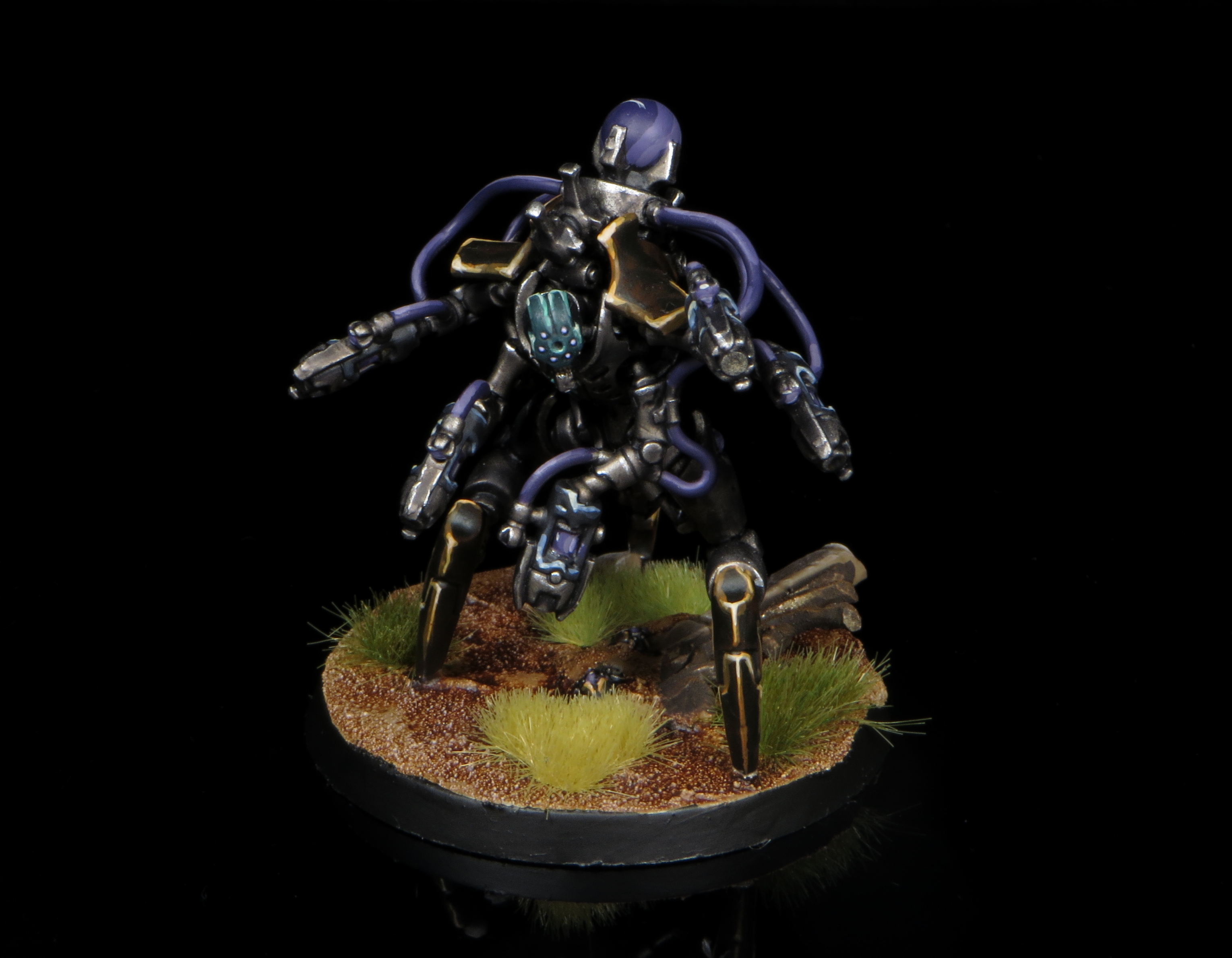
That’s also true of the Hexmark, who is reined back in from being quite such a terror. You can now only trigger Multi-threat Eliminator once per turn (across your whole army) and has to shoot the enemy that targeted the trigger unit, so no more endless volleys, and now if one Hexmark shoots another they don’t automatically fight to the death.Sad. In addition to this, the guns get a sidegrade, swapping Precision out for Ignores Cover. This I actually don’t mind, especially in concert with the other change – one Hexmark volley wasn’t usually quite enough to kill a Character, and a bit of extra reliability into Marine bodies in the current metagame seems good. I’m still expecting to consider one of these in my lists, and the extra movement is really helpful for a Lone Op.
Lastly, both the Monolith and Obelisk drop from their world-beating T14 down to T13, though do gain 2W in compensation. I don’t think this matters that much, being above 12 is the key breakpoint, but I will miss the look on opponents’ faces when I tell them. The Monolith, obviously, gets a tonne of additional support in this book, so is still likely to see a bump in people trying it. The Obelisk remains the Obelisk, shooting for the Worst Unit in the Game (un)Lifetime Achievement Award.
Sidegrades

First up here is the Technomancer, and like technically this is probably a downgrade, given he loses Lone Operative and is locked into the Canoptek Cloak build rather than getting a choice, but the ability to join Wraiths is so fantastic that you’re willing to allow it. I, for one, am very glad that I already have 11 Wraiths and multiple Technomancers painted, but very sad that I still need to paint the 12th. So many edges..
In terms of minor changes, Szeras and the Canoptek Spyder both get one. Szeras is probably closer to a downgrade – his Mechanical Augmentation aura now starts at 3”, but it can be boosted multiple times as he kills stuff up to a maximum of 12”. Obviously there’s huge incentive to take him in the Canoptek Court, where he loves the re-rolls so expect to still see plenty of action from my main man. More subtly, he’s also pretty decent when comboed with a Catacomb Command Barge – because he’s INFANTRY, the new version of the Orb allows you to suddenly drop d6 wounds of Reanimation on him at the start of a phase, which can be back-breaking with how tough he is. I still expect to run him a lot, and he’s another model where +1” move makes a big difference. Spyders see a smaller change, rebalancing their Gloom Prism to give a 5+ Feel No Pain against Psychic Attacks and Mortal Wounds instead of just a 4+ against the former. Less busted into Tsons, more broadly useful.
The most relevant sidegrade re-work is on Tomb Blades. They take the knock of Particle Weapons down to BS3+, now lose 4” of Movement if they want to take Shieldvanes, and lose their -1 to Hit. However, in exchange for all of that, the new version of Evasion Engrams is very good, allowing them to make a Normal Move of 6” after shooting (after which they cannot charge). This is extremely good on a small utility unit, giving them extra movement reach and the ability to get funky after coming on from Reserves, and also makes using a larger unit of these as an actual chip damage dealer seem a bit more reasonable. They’re still one of the best utility choices in the book after this, and I think it’s more likely they find greater utility after this change than diminished.
Finally, the Convergence of Dominion.
Gunum: I’ll take this one Wings, don’t worry. These towers have seen quite a bit of a change versus how they work now. At the cost of some toughness and wounds, we can now take these in singles! How would you like super cool monoliths hanging out in the corners of your deployment zone, because I would! Their utility ability has changed, substantially though. Now, instead of providing a reroll to reanimation protocols within 6”, they provide a 6+++ within 6”. This is situationally useful I feel, and depending on the cost/deployment rules (Remember when you could teleport them around?! No?) they could provide a needed layer of defense for Skorpekh or Lychguard now that they have lost their access to Technomancers. They still have their cool guns, the Transdimensonal Abductor, which is almost a perfect weapon for bullying some out of place Terminators. Is it better than before? Kinda. I’ll report back.
New Ways to Use Units
As mentioned up top, there are enough changes that most units that see significant tweaks to their roles have already been talked about, but there’s a few more angles to ponder both on them and others
First up, the cheap Canoptek shooting platforms (the Doomstalker and Tomb Sentinel) are massively better in the Canoptek Court than they have been previously, both hitting higher peaks of reliability and being able to play a more mobile game without needing to be tied to a buff aura.Scarabs are also liable to see a bit more flexible use, as they can now sometimes pick up some OC, and are OK at carving through chaff when they’re on full hit re-rolls.
Next, the Epic Hero C’tan definitely feel more like something you can expect to slot into a list and just get value from now. All three of them felt nearly there before, but not quite tough enough, and layering the extra Feel No Pain on top (plus the damage boost for the Nightbringer) should get them over the line.
Finally, I think small units of Skorpekh and Lokhust are now much more likely to see some use as roleplayers, especially if they keep their current points. Both will usually be throwing down full hit re-rolls the turn they first strike, which probably means they threaten enough damage that they’re kind of worth it? I certainly expect to try this out in builds that feel like they’re short one more mid-tier roleplayer. Three Skorpekh with a Lord could also do some OK work, as adding the Lord’s Mortals plus stacking Lethal Hits with full re-rolls makes them properly scary to some popular metagame choices.
How They Will Play

What I really like about this Codex is that it keeps the combo-centric theme of the Index, while significantly broadening the options available. I suspect you’re still planning to try and anchor your army with a relatively tough unit of some kind (most likely Wraiths or Warriors now), then using the various damage dealing/mobility combos and tricks the various detachments provide you with to put the enemy in the ground. You definitely need more proactive plans than the Index choice of sitting behind unkillable Lychguard, but this book in general provides far more options for doing just that – your toys are a bit faster and a bit killer, and you have four new detachments to tinker with. I really like this Codex, and am desperately looking forward to slamming some lists down on the tournament tables. Also painting Doomstalkers. I’m not looking forward to that, but I am doing it.
Army Lists
So, please remember as mentioned at the start that we are working from the MFM points, with the exception of using the book price for the new Overlord with Translocation Shroud and Enhancements. Everything is subject to change and we’ll have updated lists as soon as we know what we’re working with. For now, however, enjoy my diabolical interim creations.
Canoptek Court
This detachment rips, and I intend to do my level best to unleash its potential upon the world. Here’s where I’m at right now:
Characters
Technomancer, Dimensional Sanctum
Technomancer
Technomancer, Autodivinator
Plasmancer, Metallodermal Tesla Weave
Overlord with Translocation Shroud
Illuminor Szeras
Royal Warden
Hexmark Destroyer
Battleline
20 Warriors with Reapers
10 Immortals with Tesla
Other
6 Wraiths with Particle Casters
6 Wraiths with Particle Casters
Cryptothralls
Cryptothralls
Canoptek Doomstalker
Canoptek Doomstalker
Canoptek Doomstalker
I, for one, welcome hit re-rolls to the Necron Codex, and shall be doing my level best to encourage them to go further. This build has a good amount of board presence from two units of Wraiths and the Warriors, reliable routine shooting from the Doomstalkers, and a horrendous sucker punch from the speedy Immortals popping Cynosure of Eradication. This list uses a bunch of units that I really like, so I’m excited to slam it onto the board.
Hypercrypt Legion
This one is me getting weird with it – I’m sure a lot of experimentation will be needed to work out how best to put this one together, but this looks like an absolute blast.
Characters
Teleport Overlord, Osteoclave Fulcrum
Plasmancer, Arisen Tyrant
Nightbringer
Void Dragon
Imotekh
Psychomancer
Battleline
20 Warriors with Reapers
Other
5 Lychguard with Shields
Cryptothralls
6 Lokhust Destroyers
3 Tomb Blades, Shieldvanes, Shadowloom, Particle Casters
3 Tomb Blades, Shieldvanes, Shadowloom, Particle Casters
Lokhust Heavy Destroyer
Monolith
The centrepieces here are obviously the big Warrior unit with the stacked buffs, ready to teleport in, murder something with full re-rolls then bug out, plus the Monolith to help them do…whatever they like. I figure that a small unit of Lychguard with Imotekh is a neat choice here, because in an emergency you can essentially hurl them straight into combat, and to finish up we do, of course, have a couple of C’tan. Love C’tan. Number one C’tan stan, right here.
Final Thoughts
I’ve been playing Necrons solidly this edition – they’ve been so much fun that I simply haven’t wanted to get my Aeldari out. Having digested this book, I am incredibly excited to continue doing so – there’s a bunch of great stuff to play with here, and I can’t wait to try some of it out. Quite genuinely – I am going to play one (1) tournament with Aeldari next weekend, because I hate playing lame duck armies after I’ve digested the book, then it’s back on the skeleton train for the foreseeable future. Great stuff in this book, and I hope other Necron players are as excited as I am!
